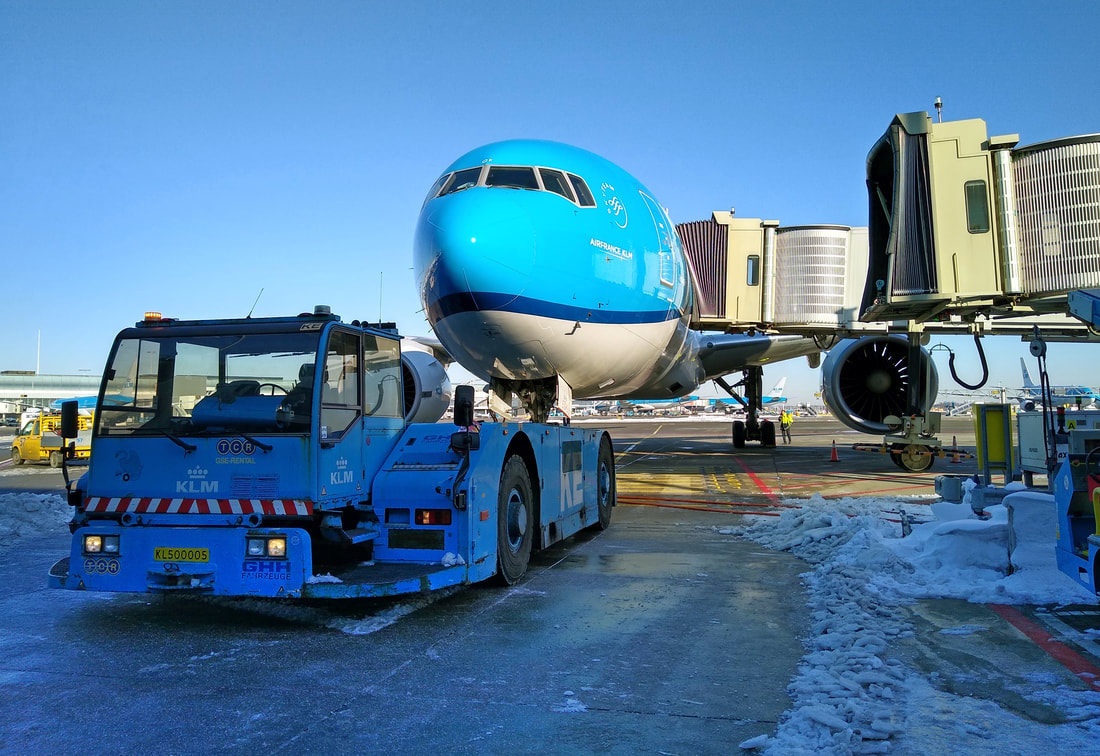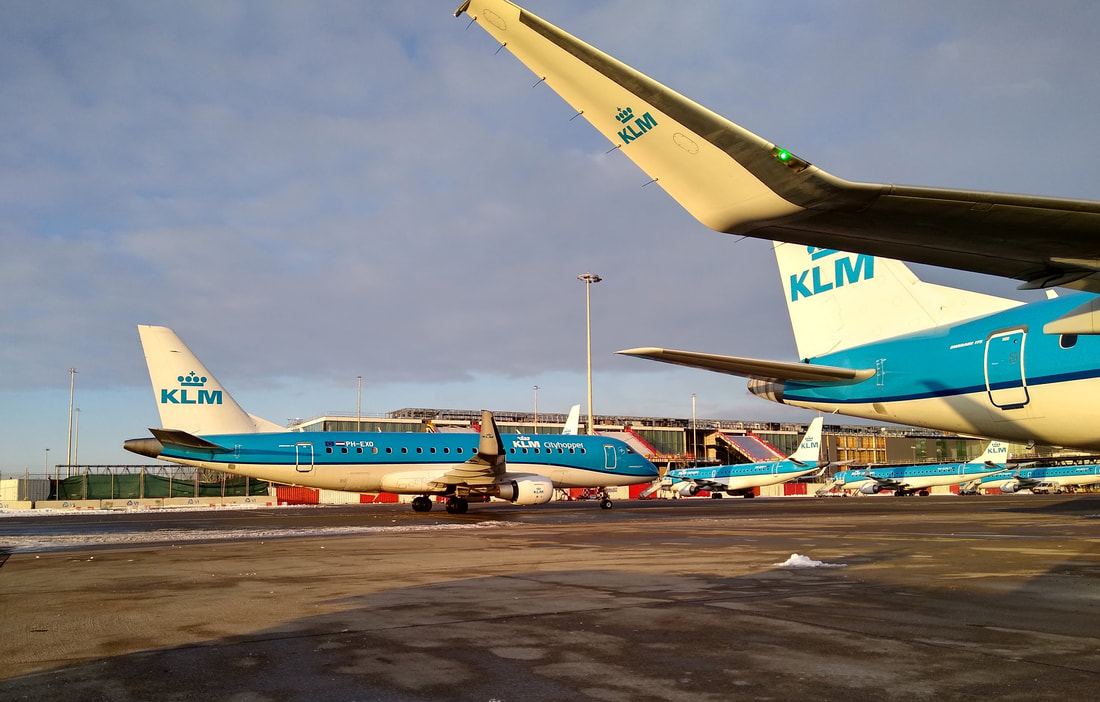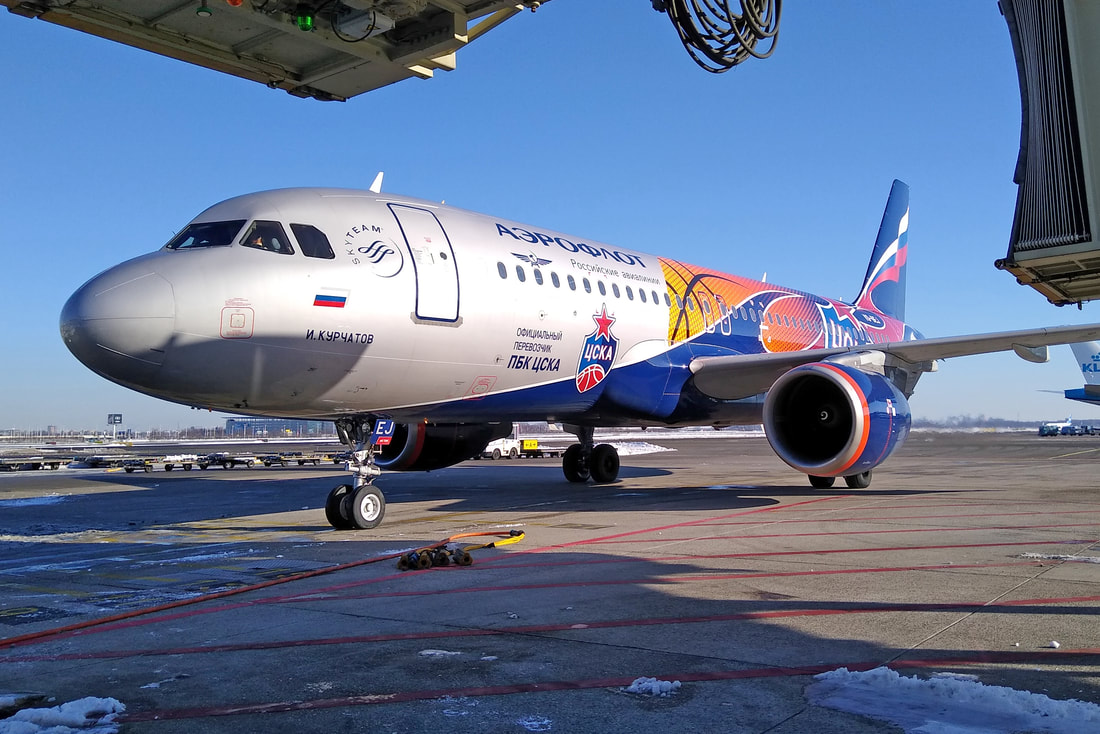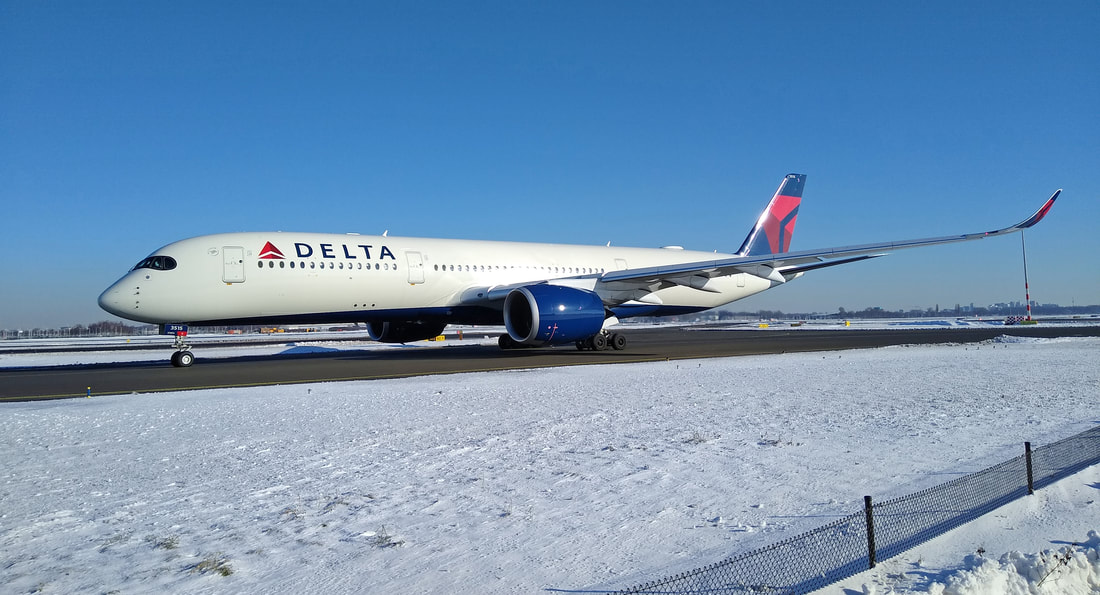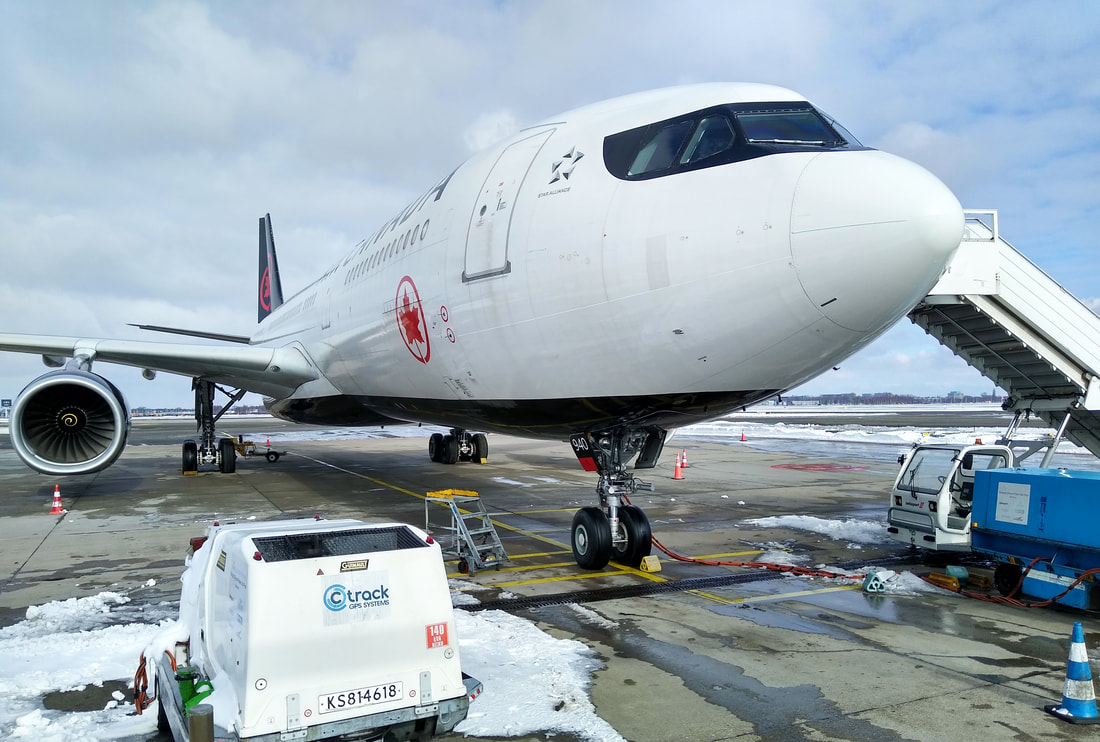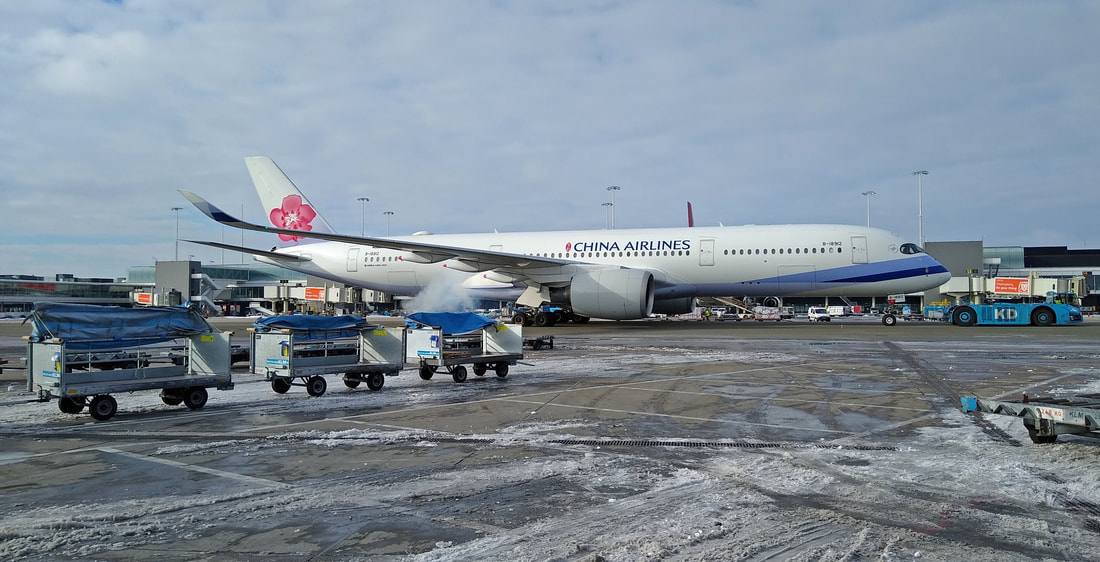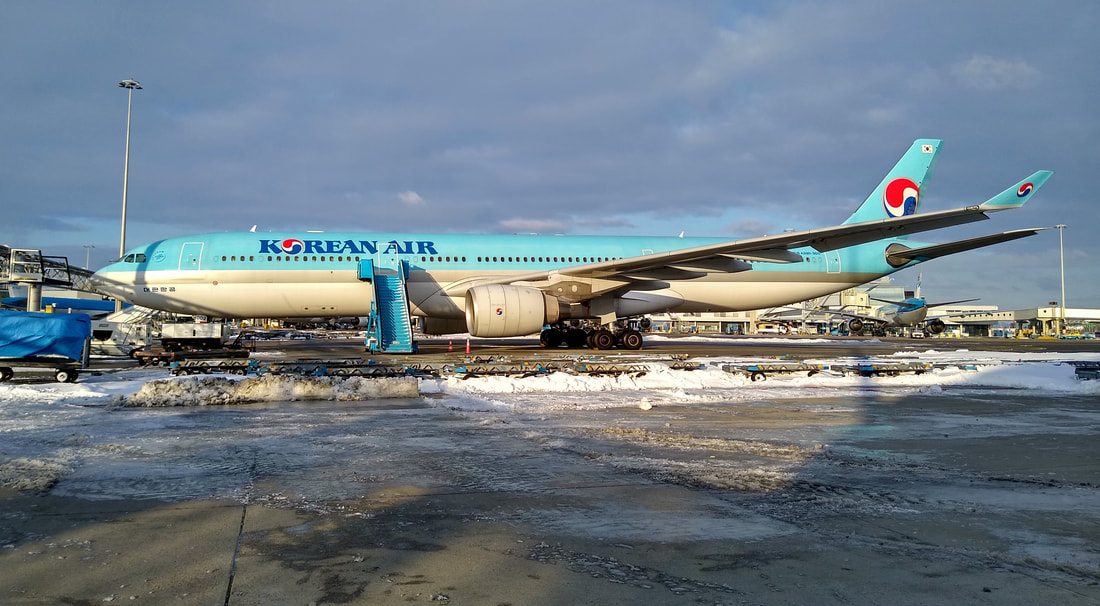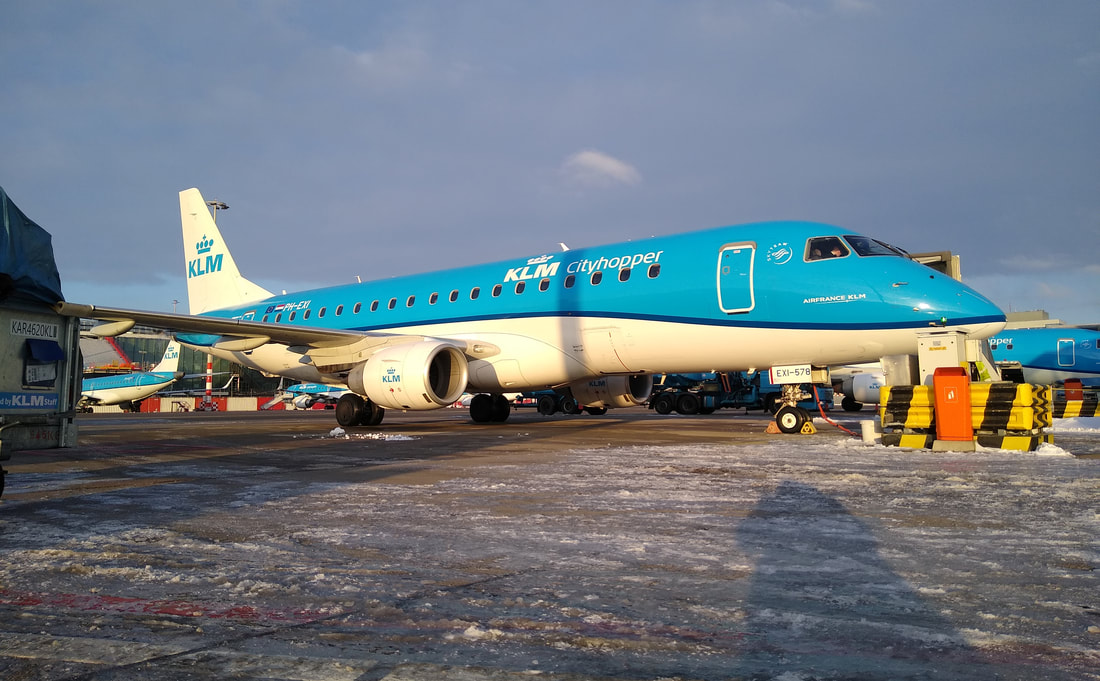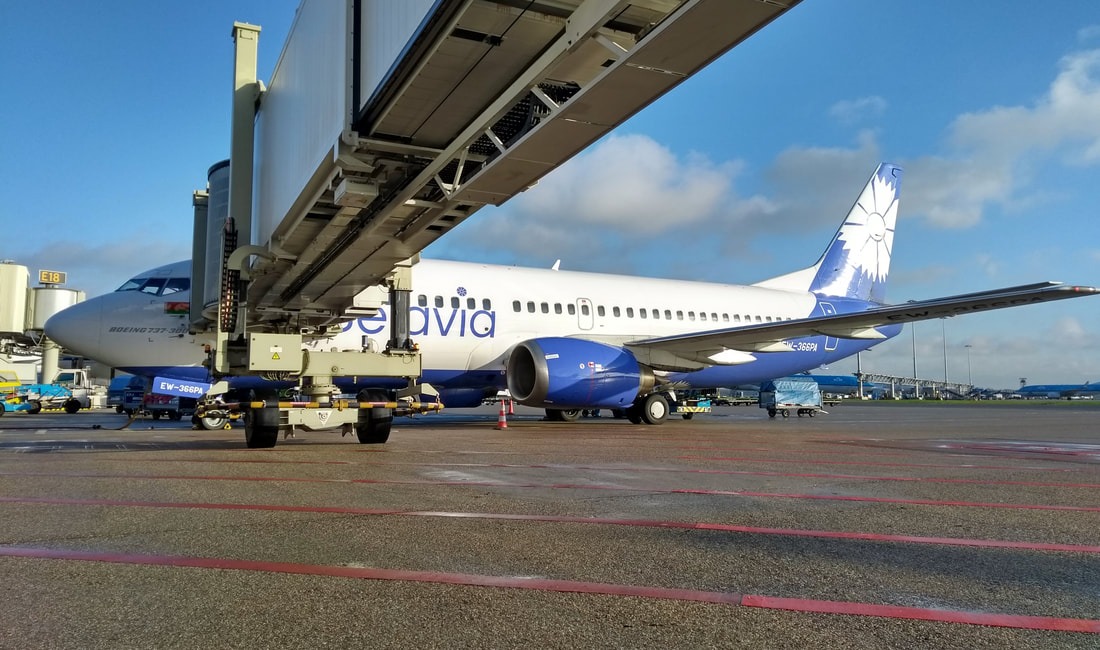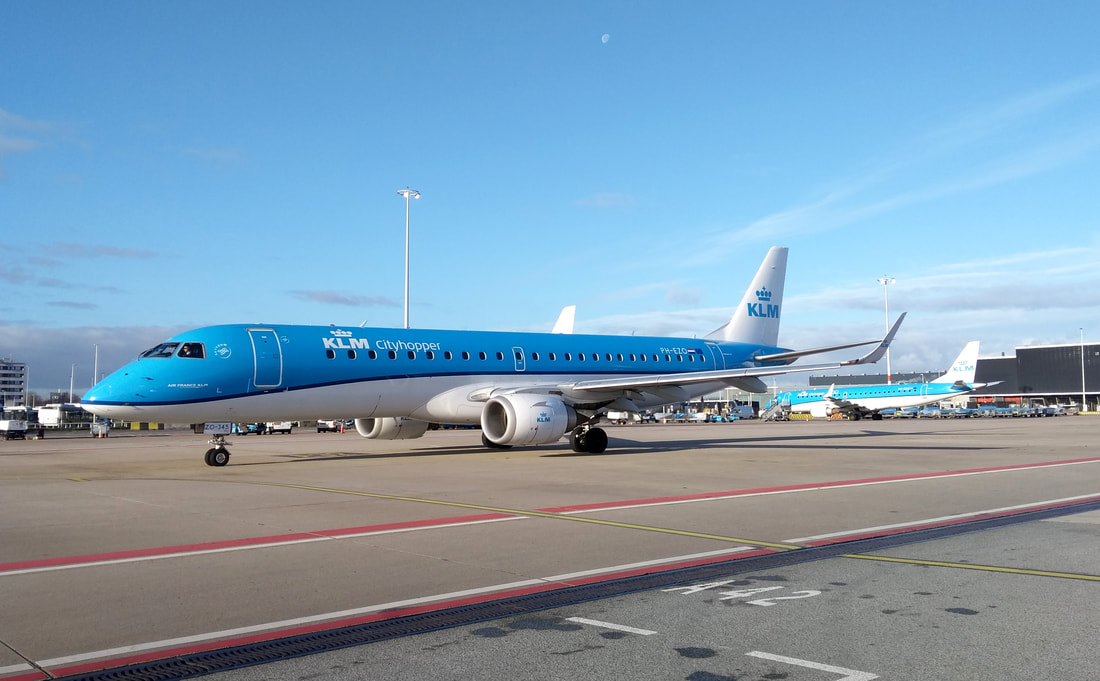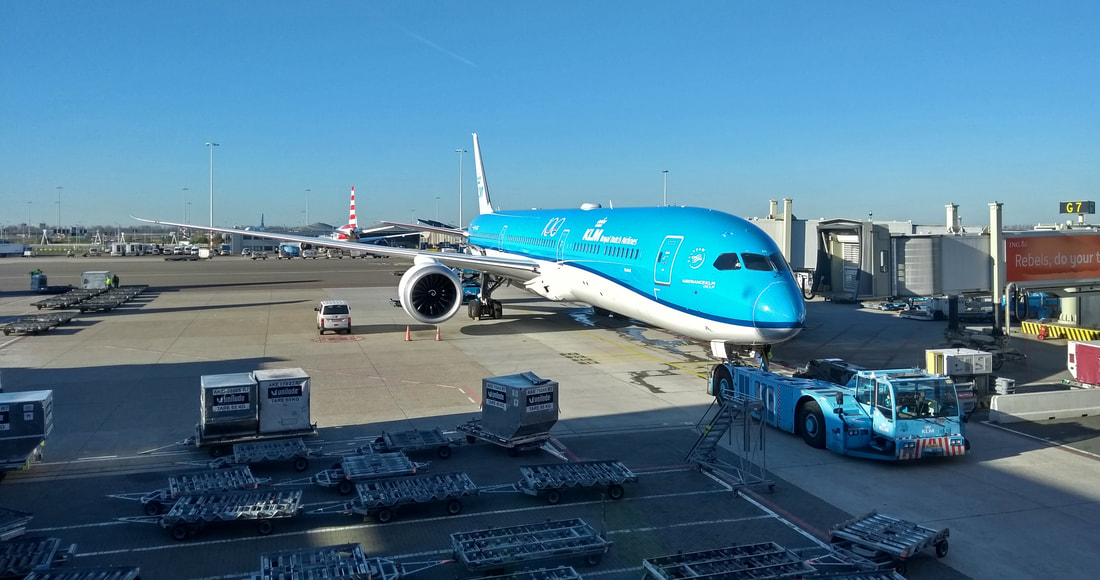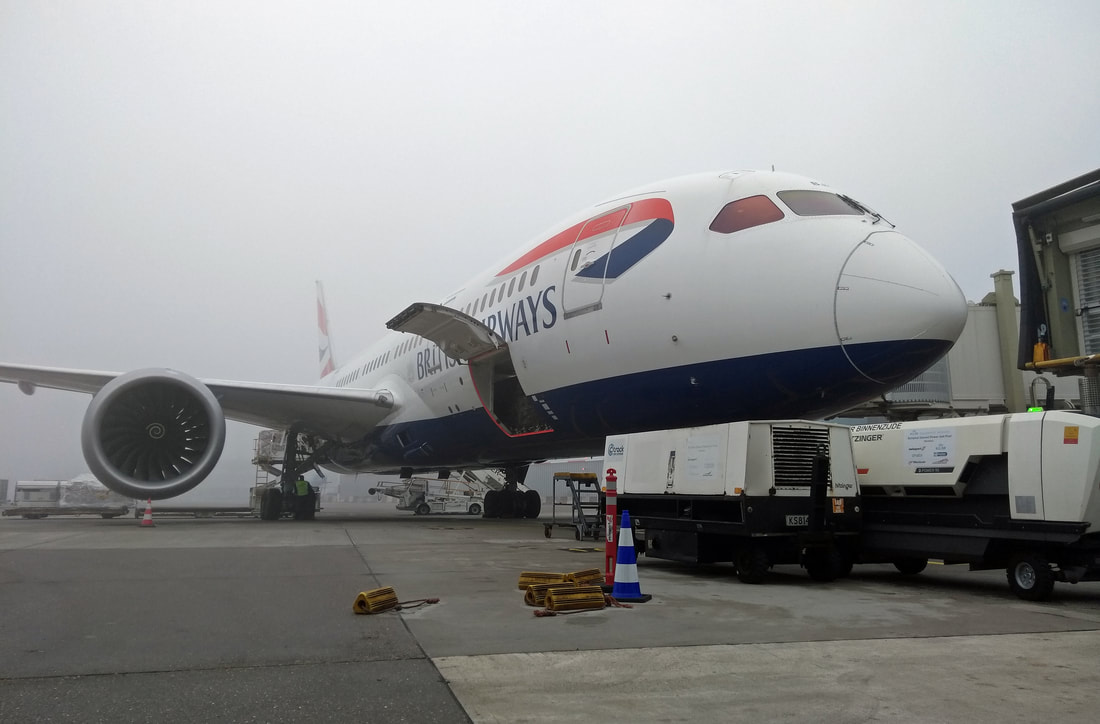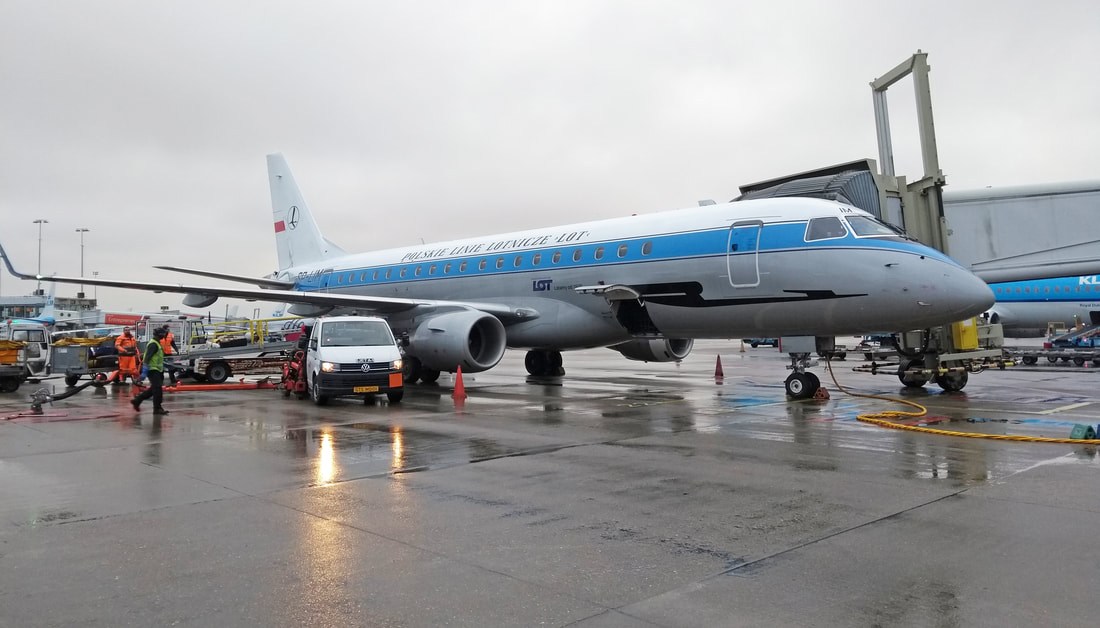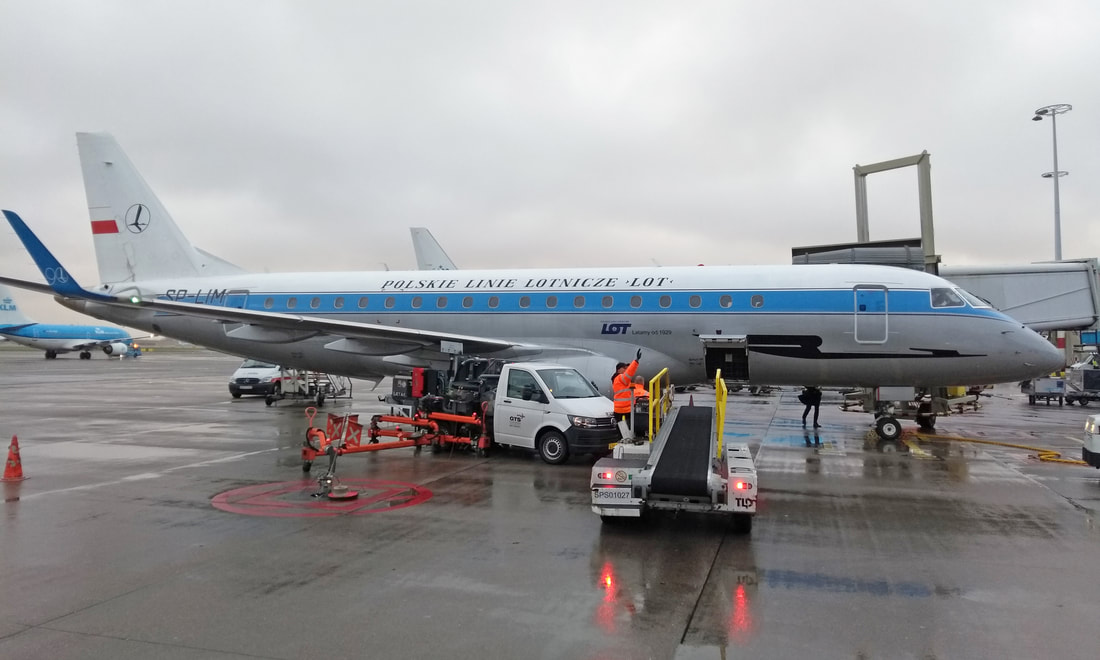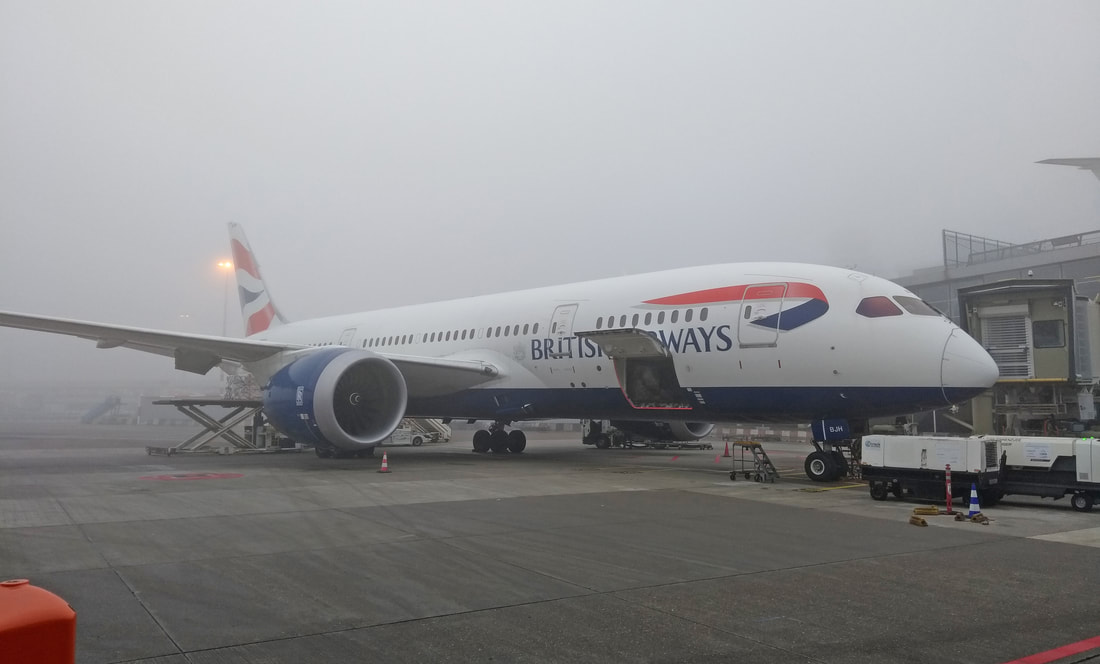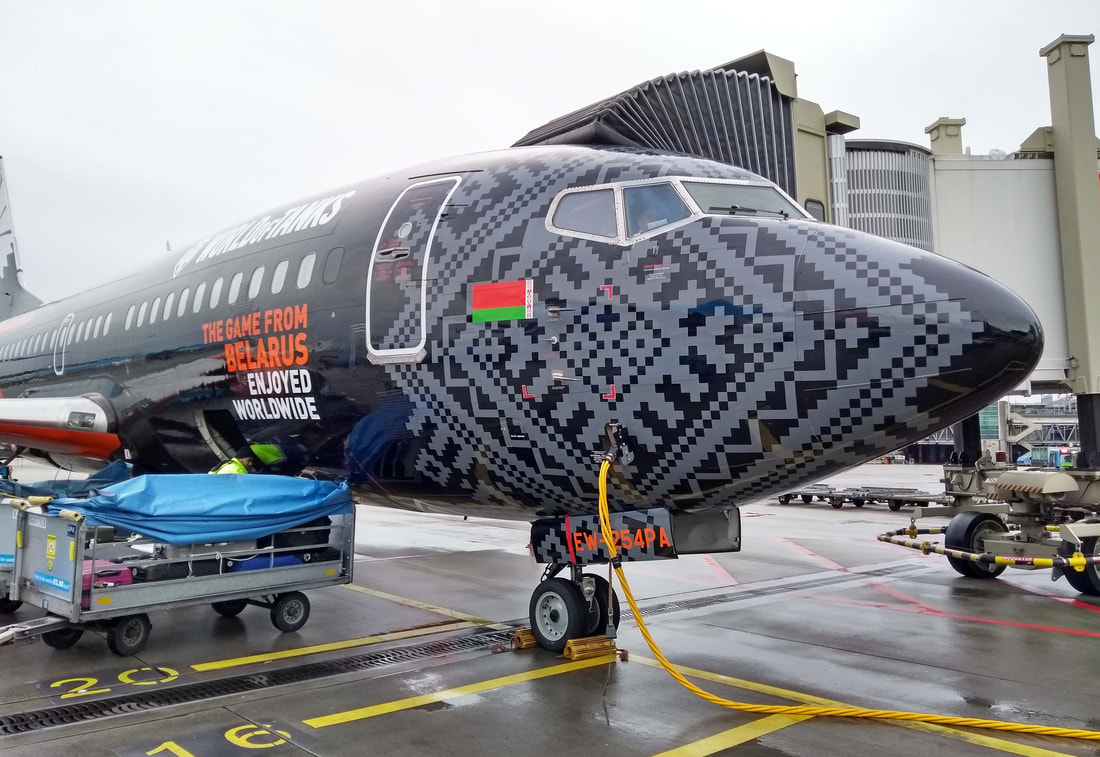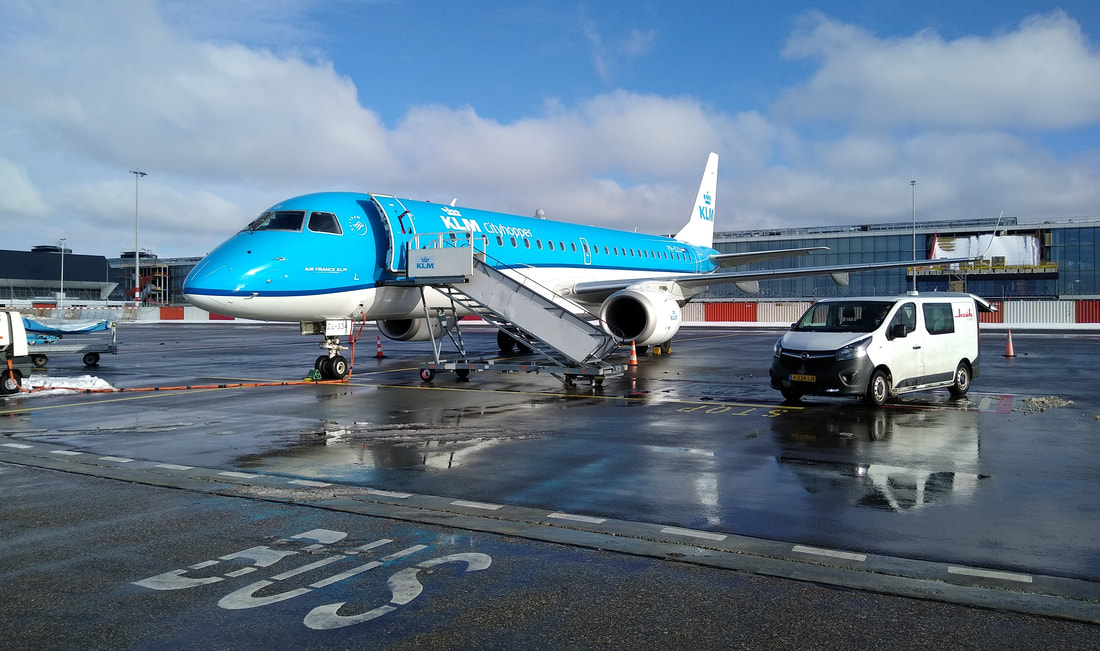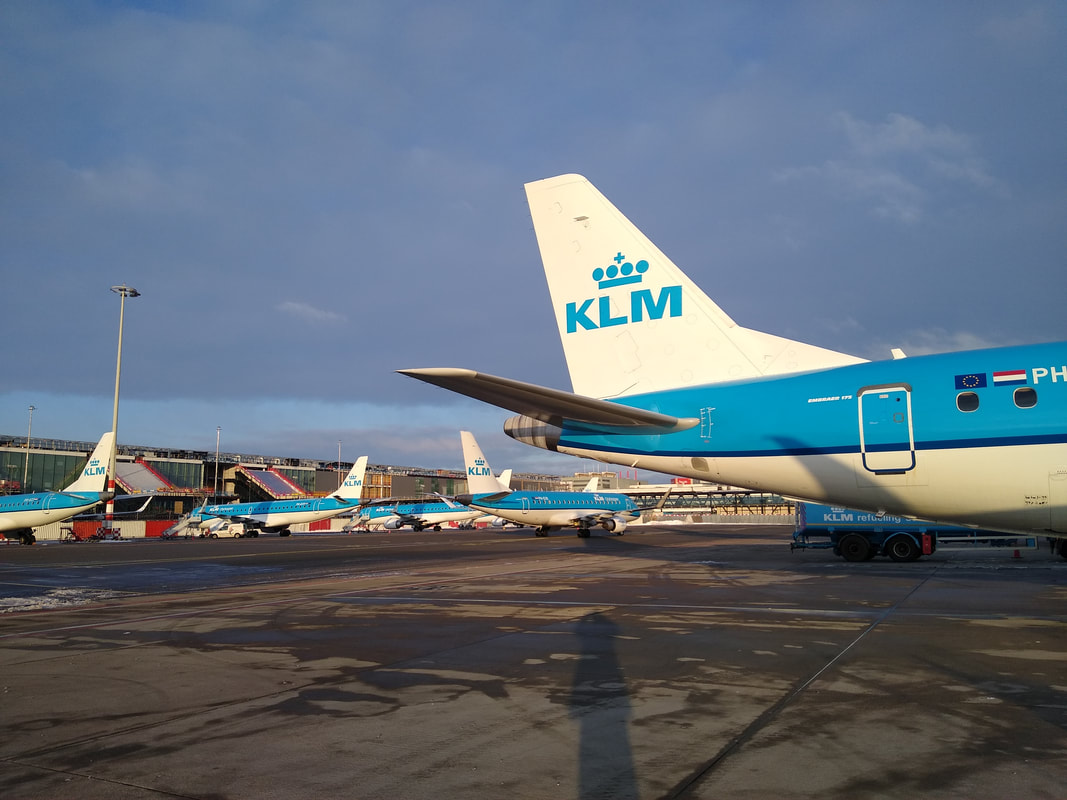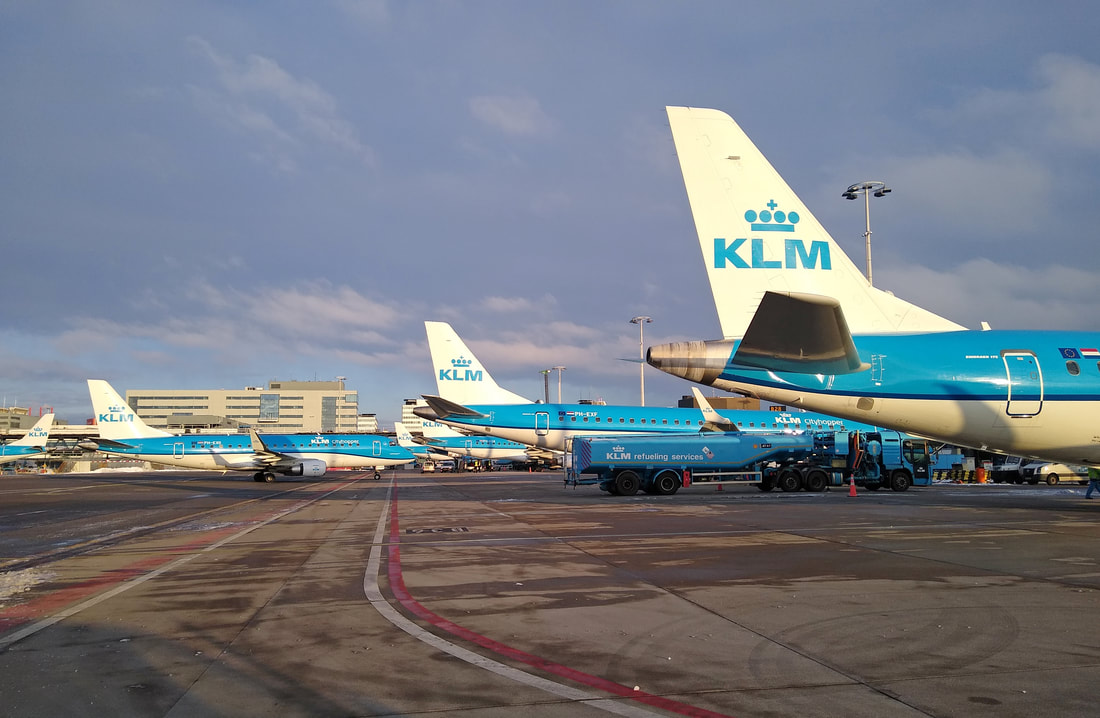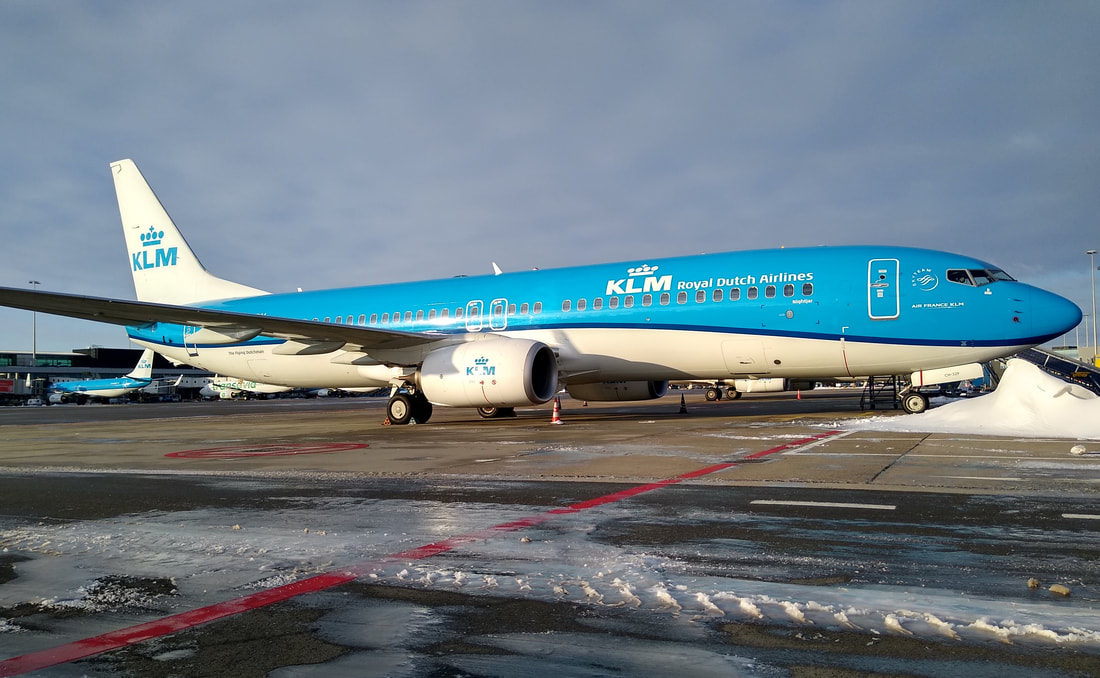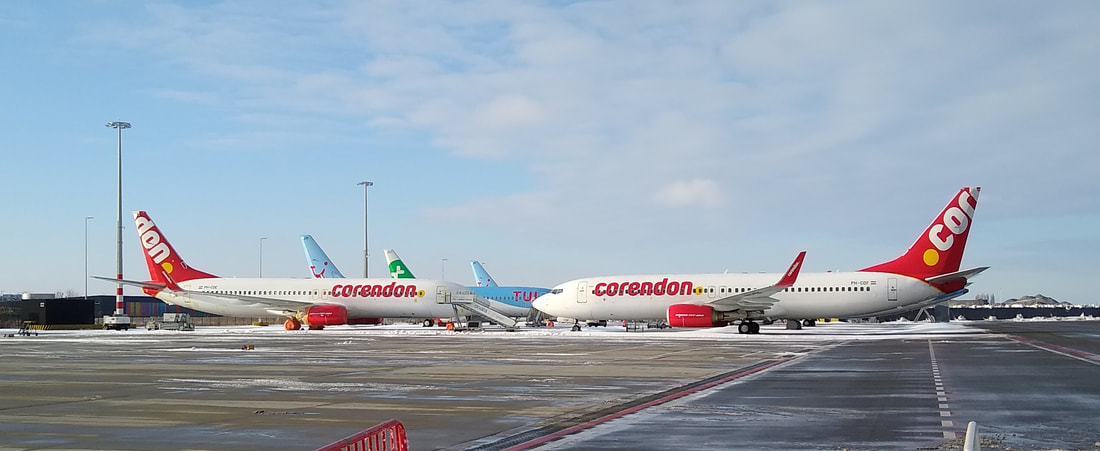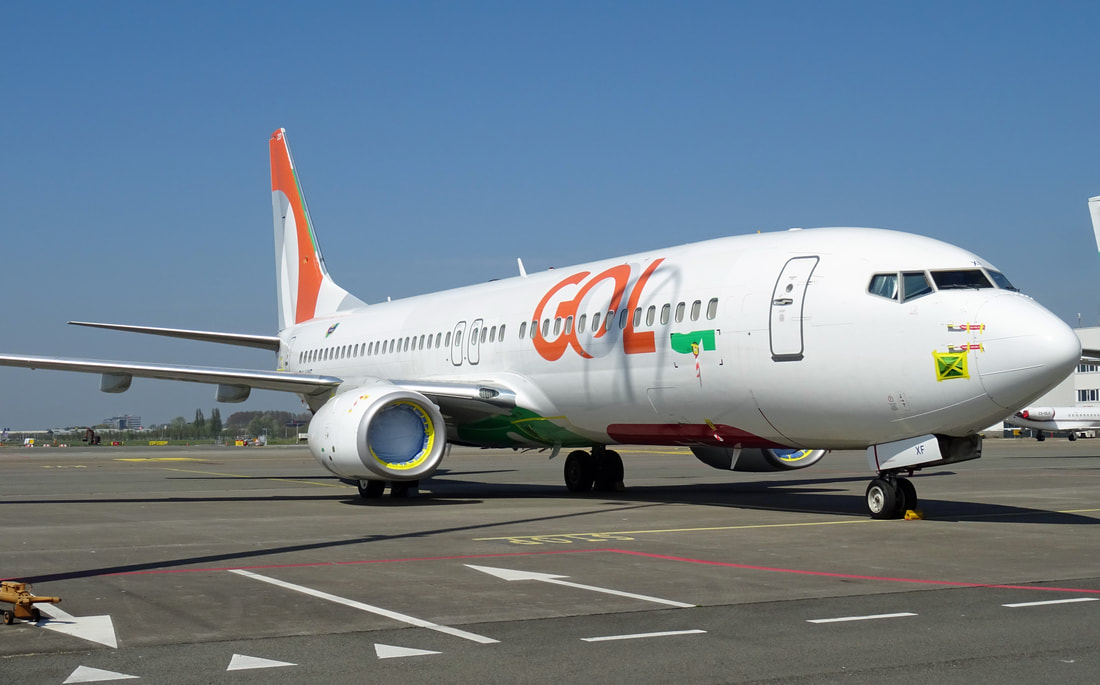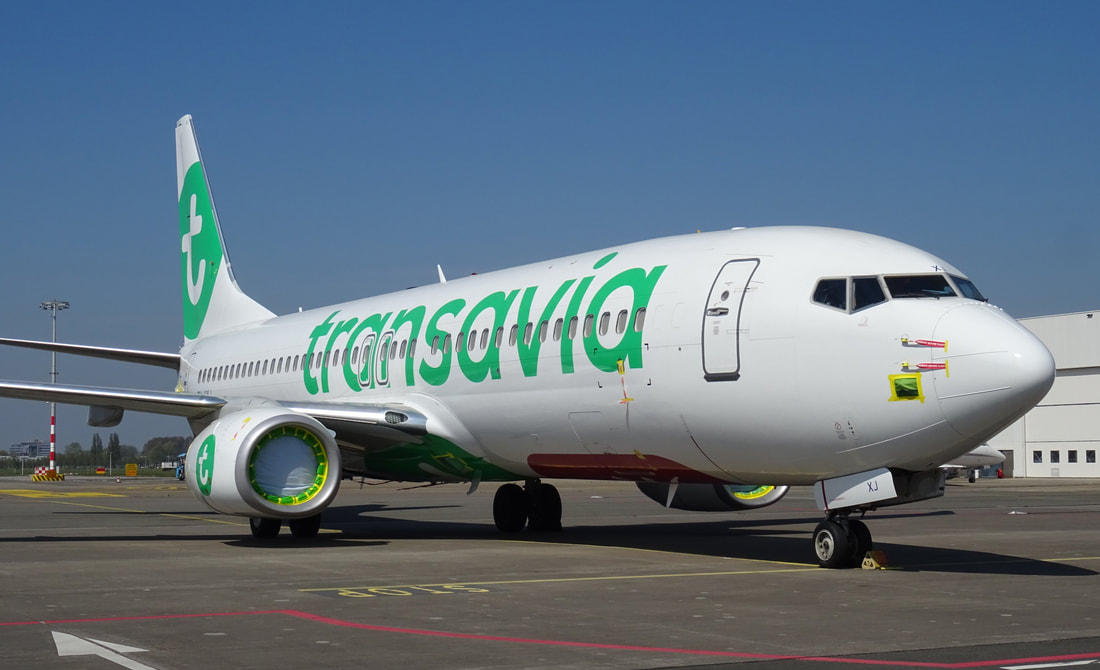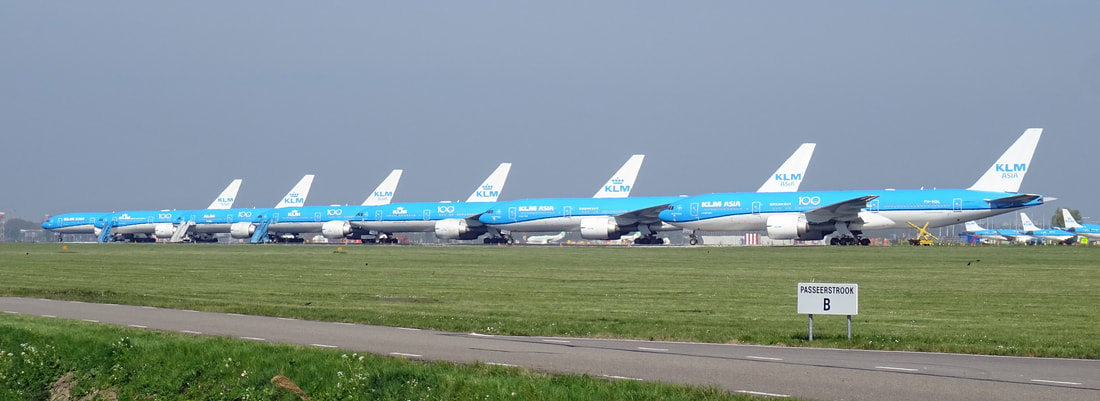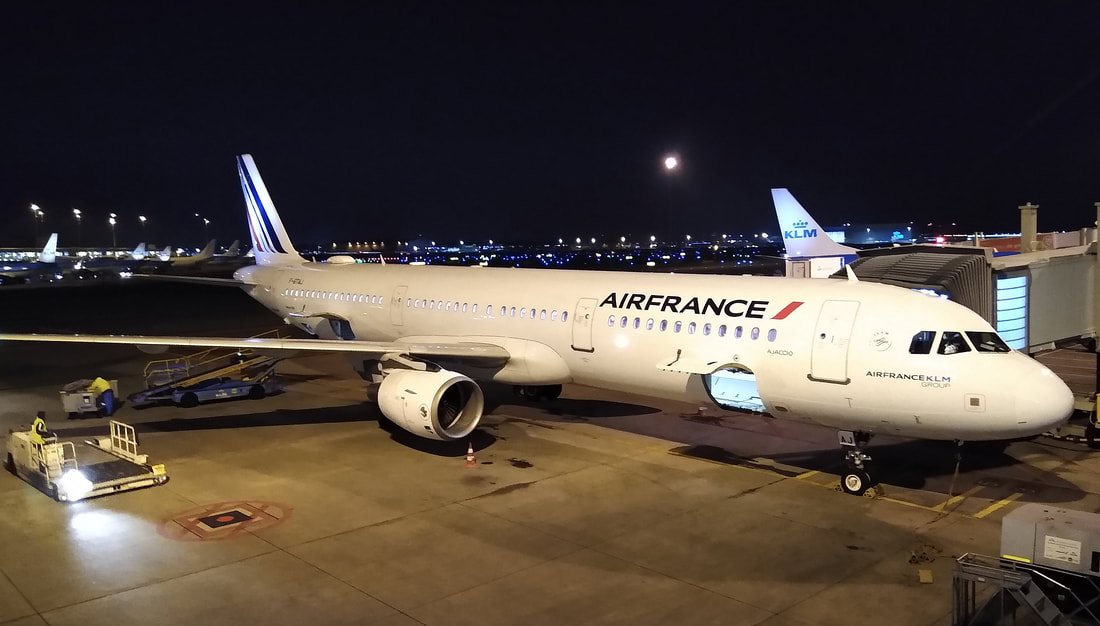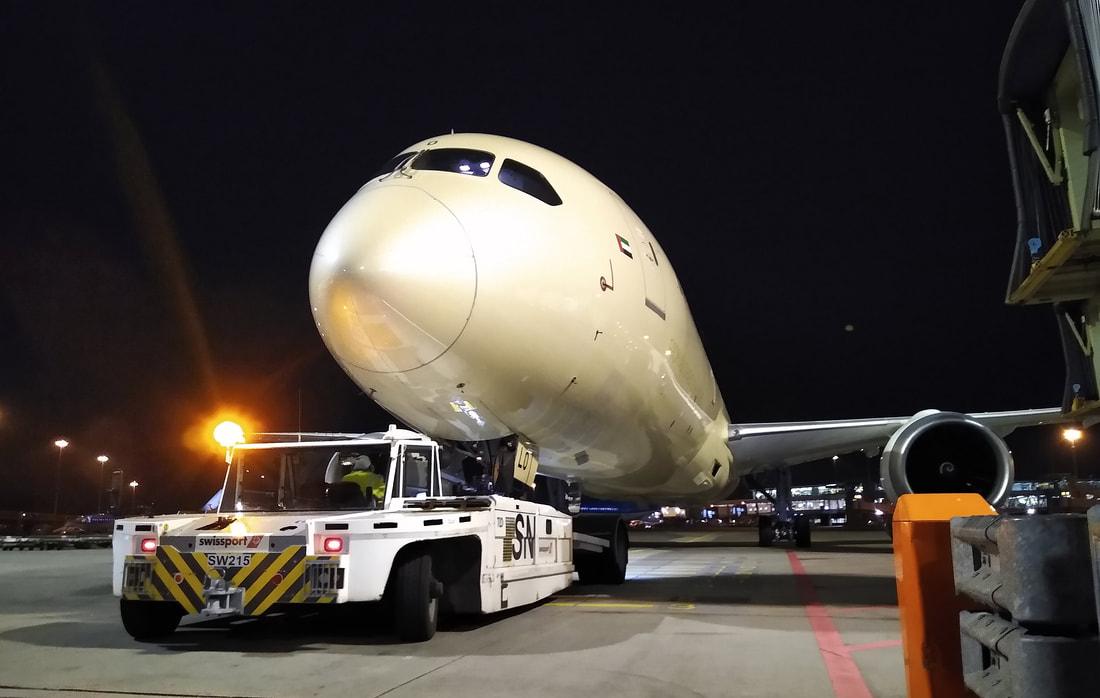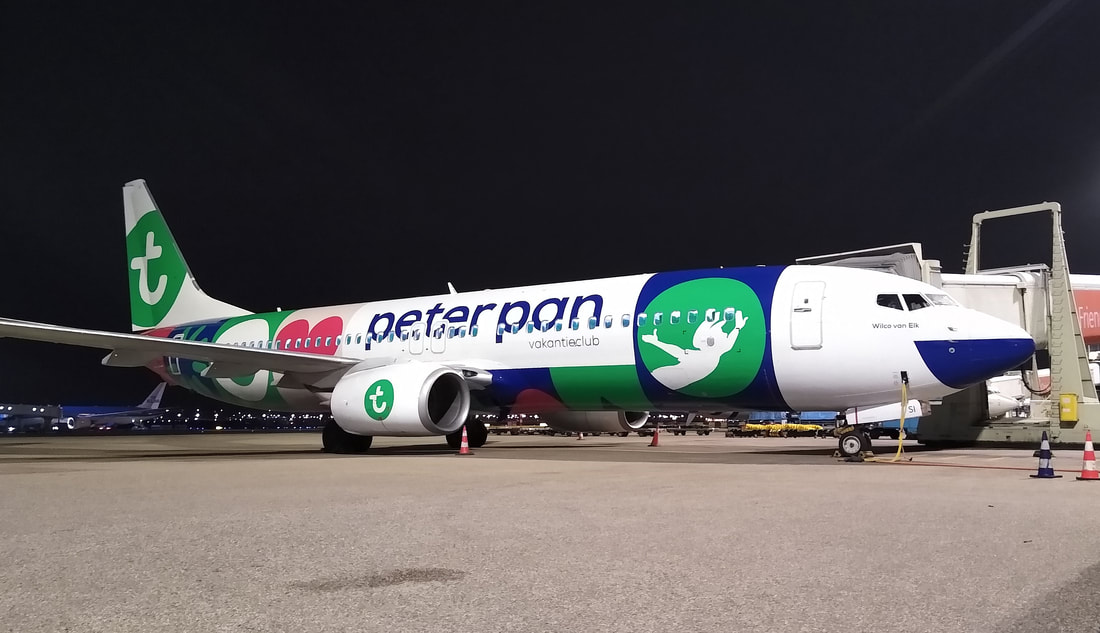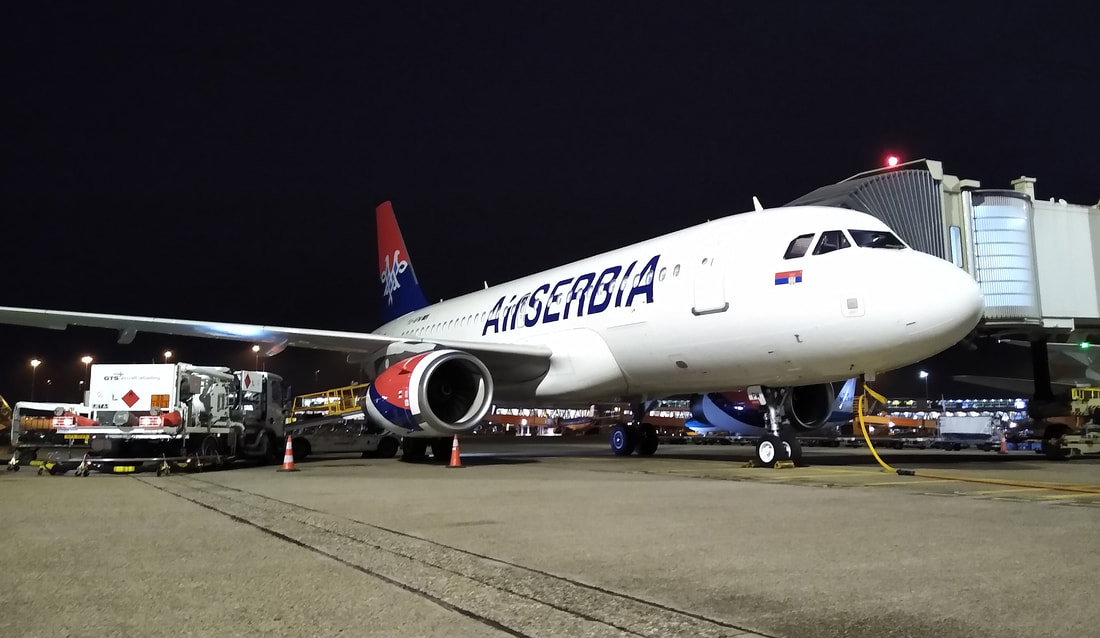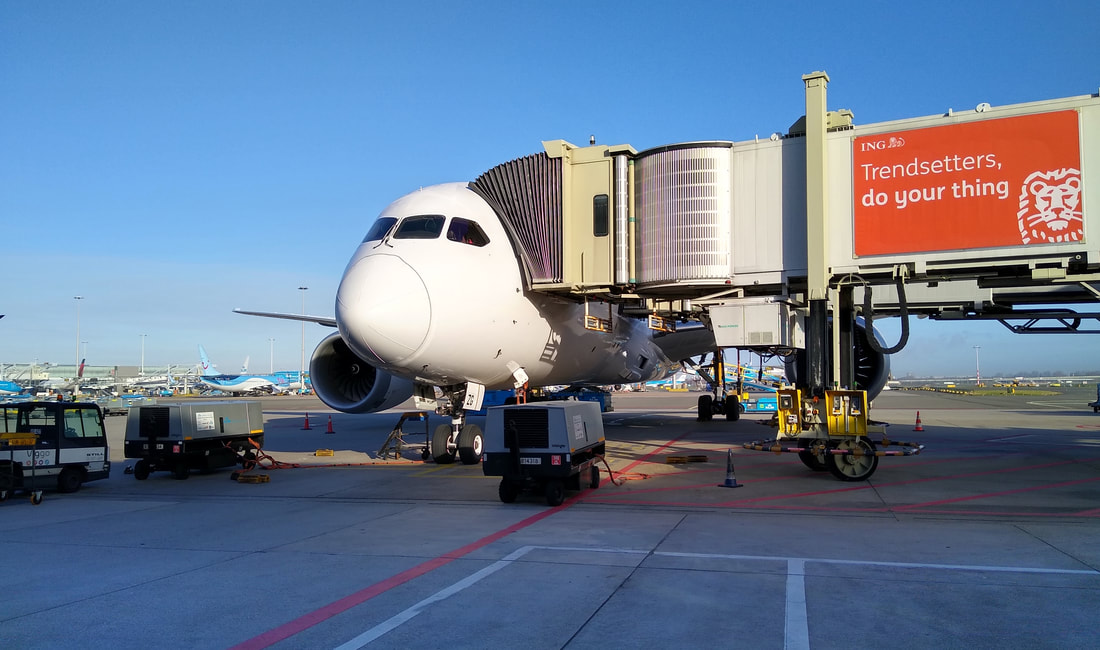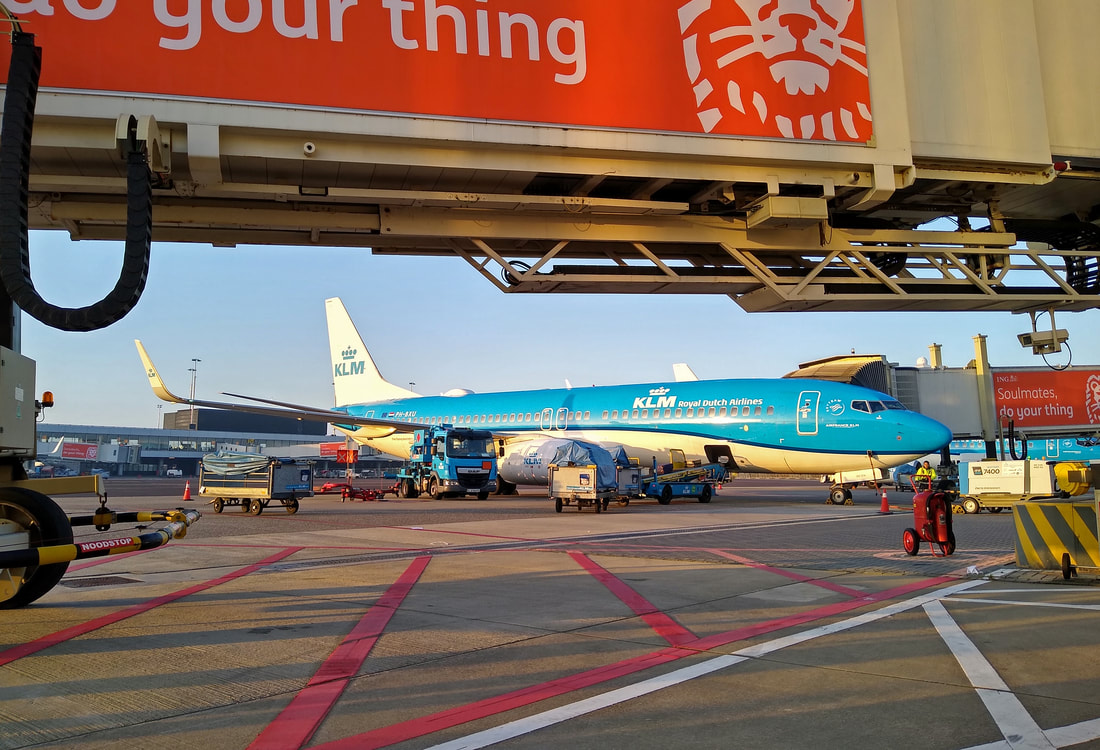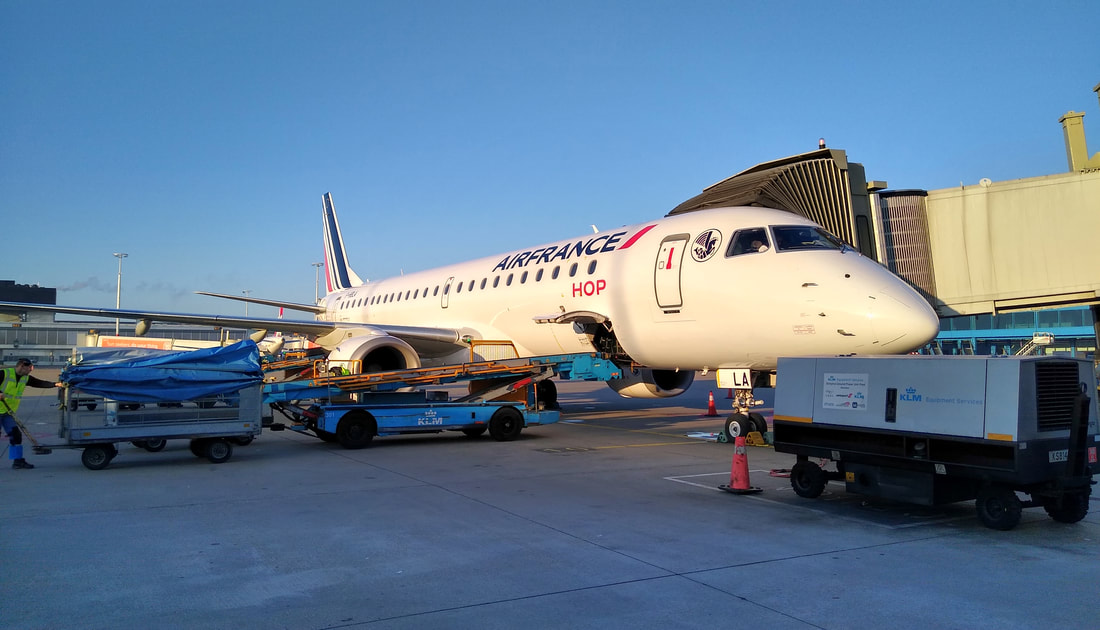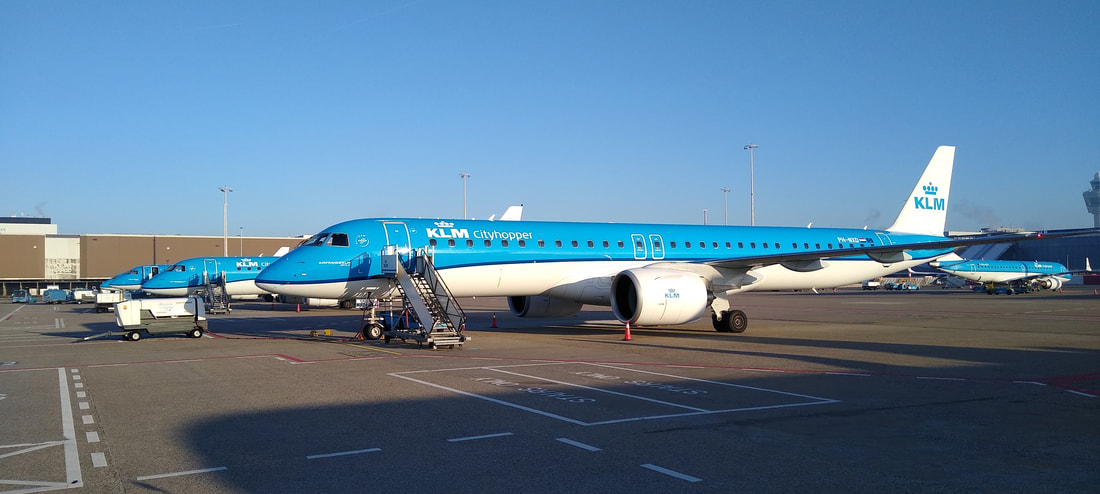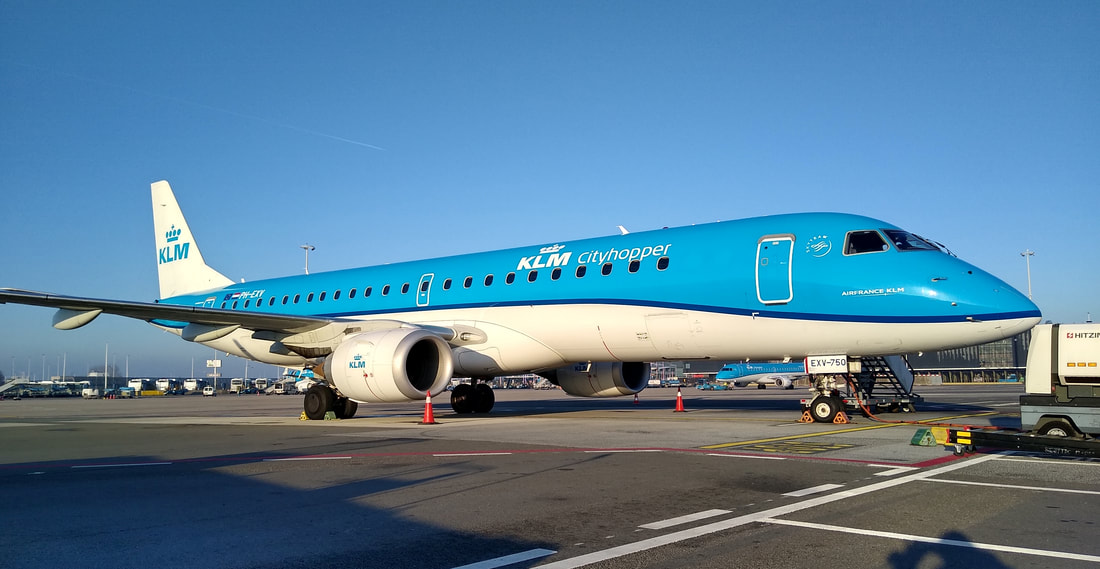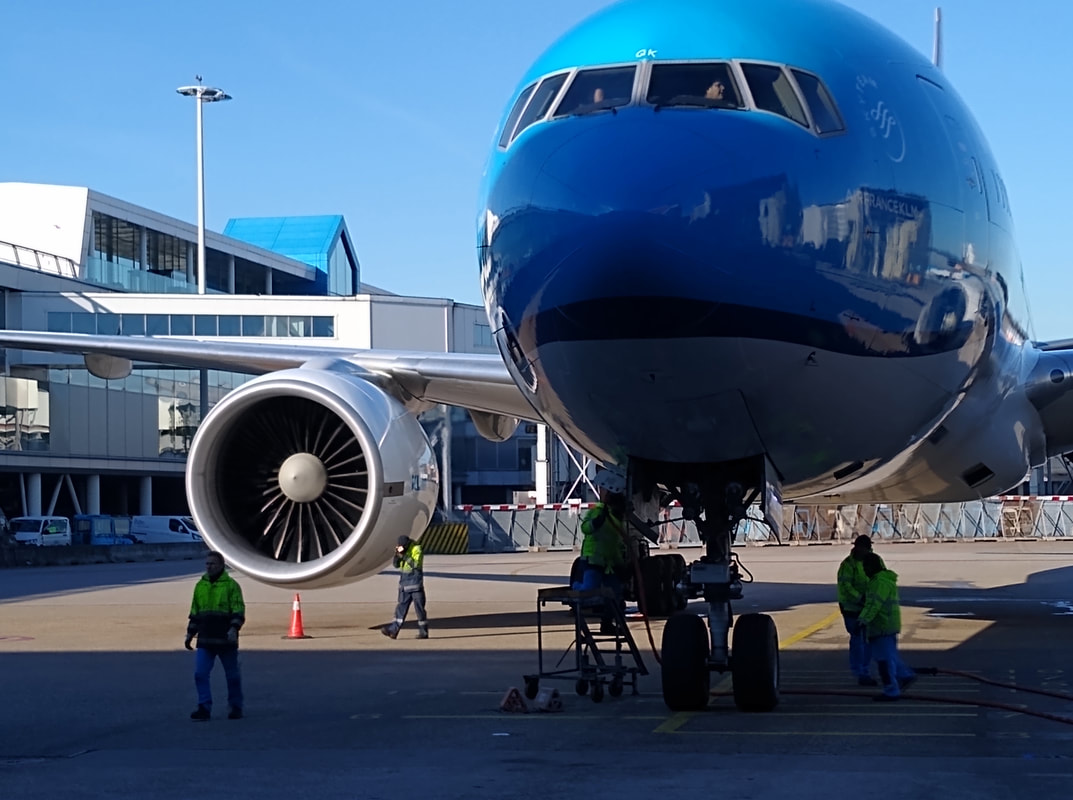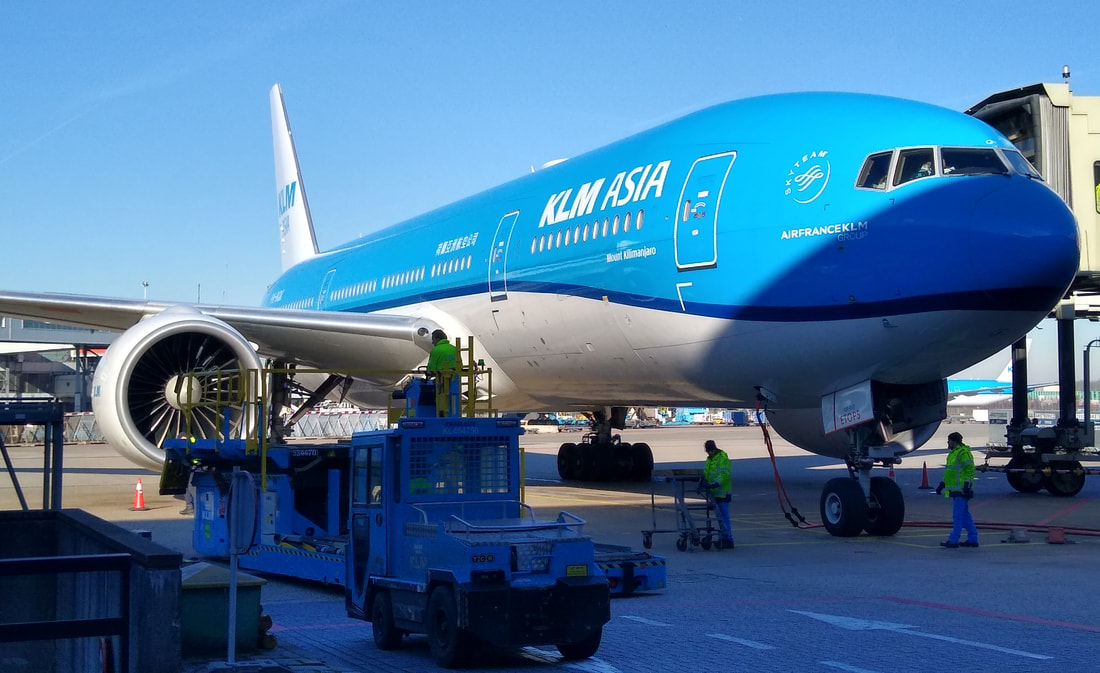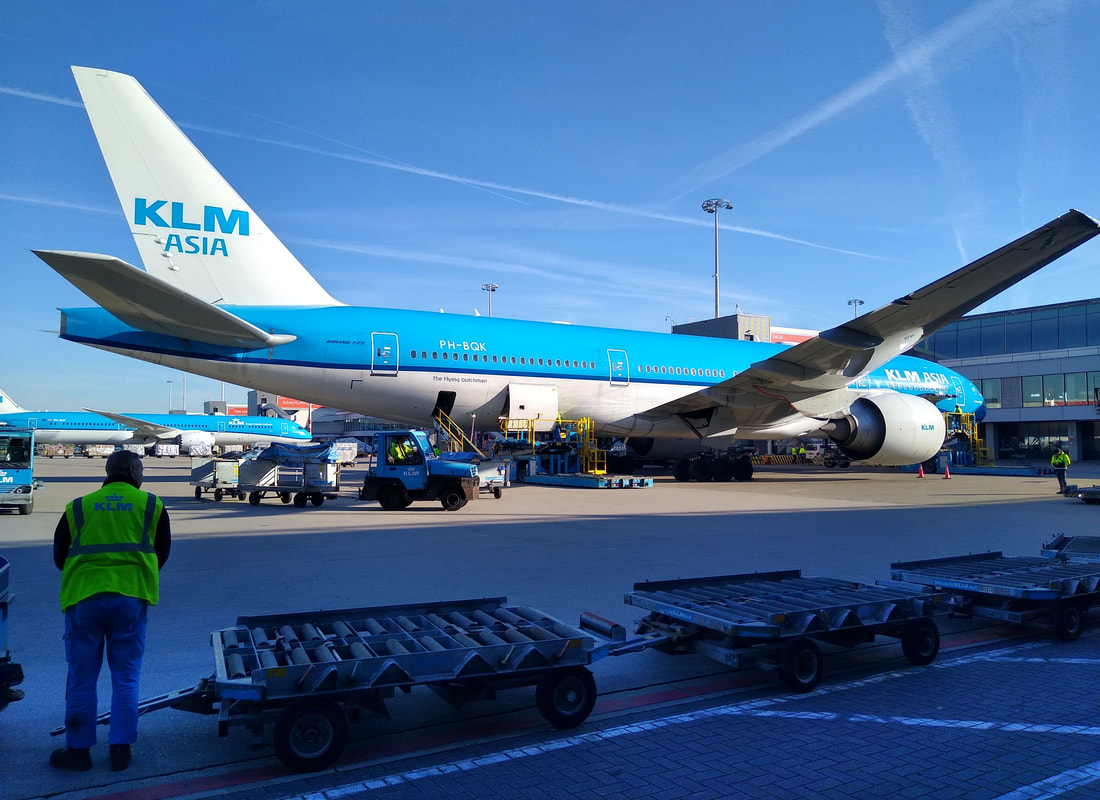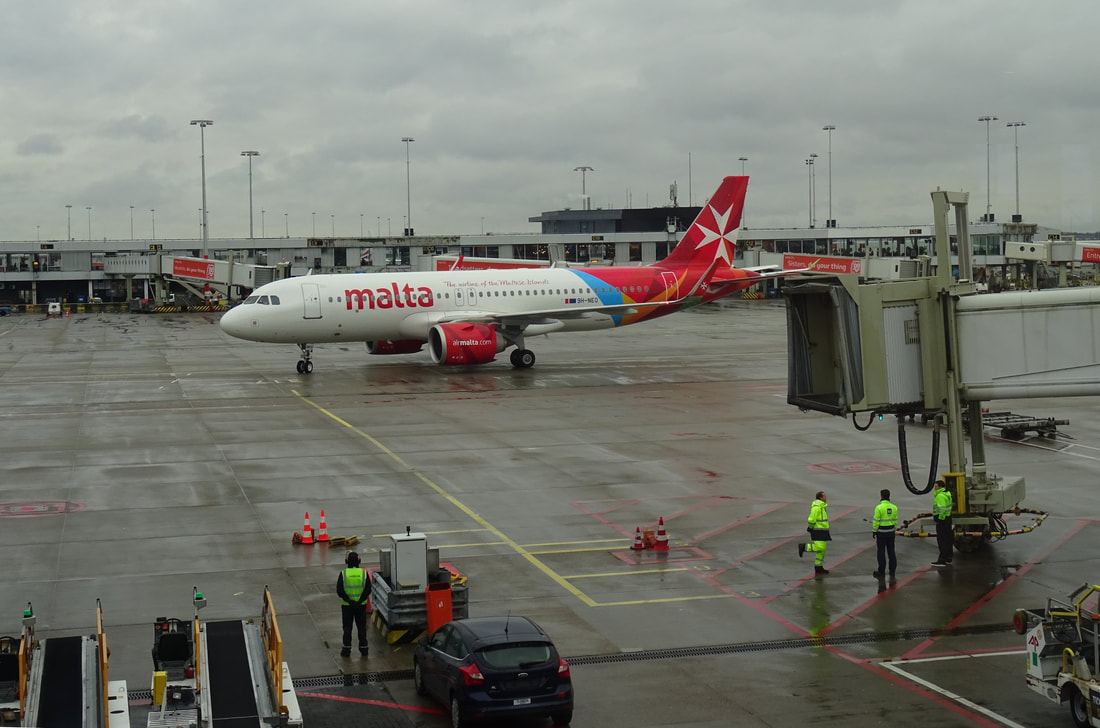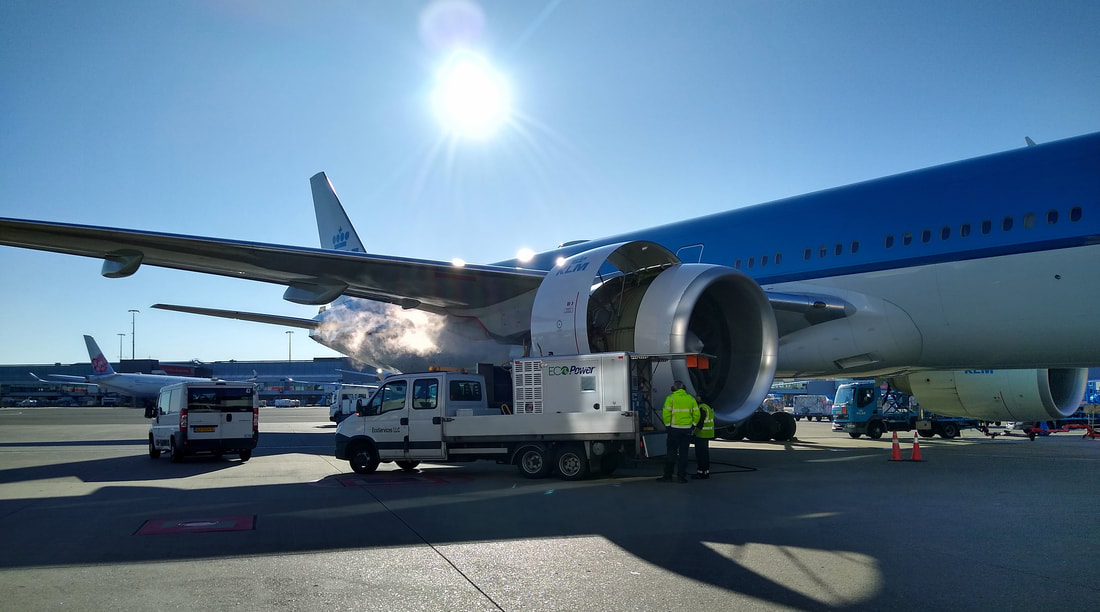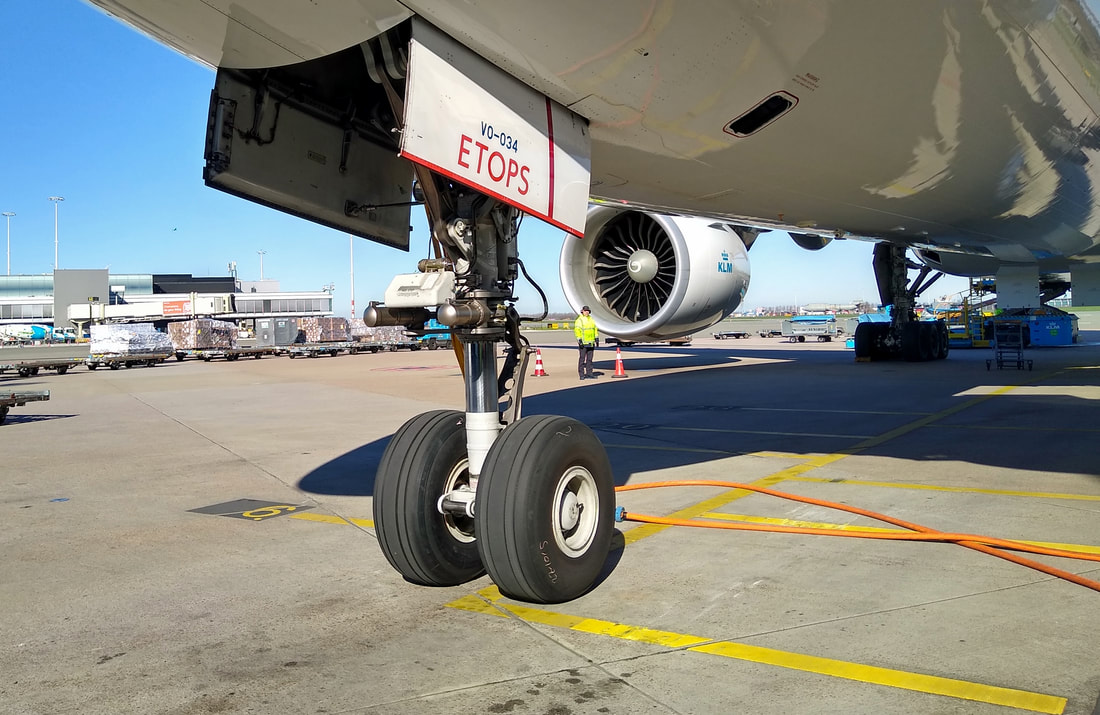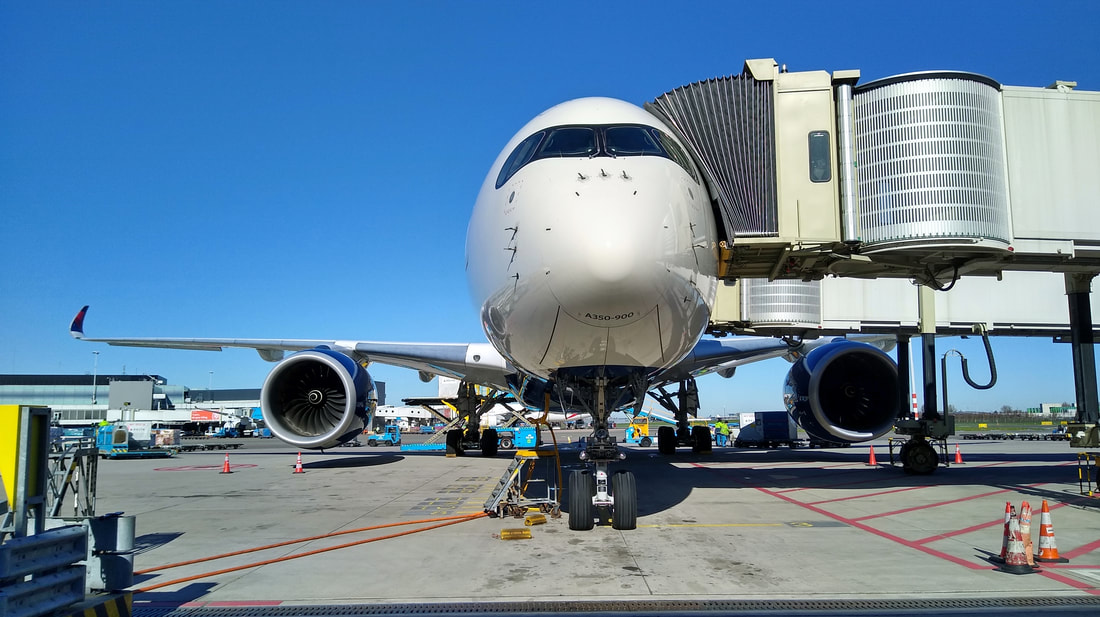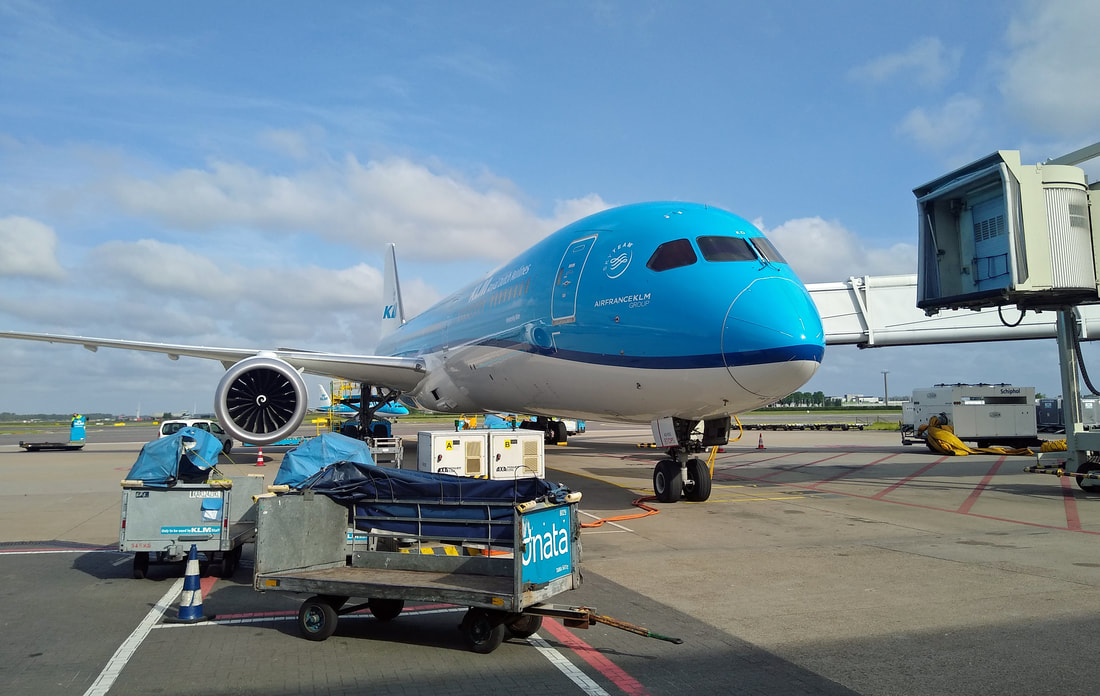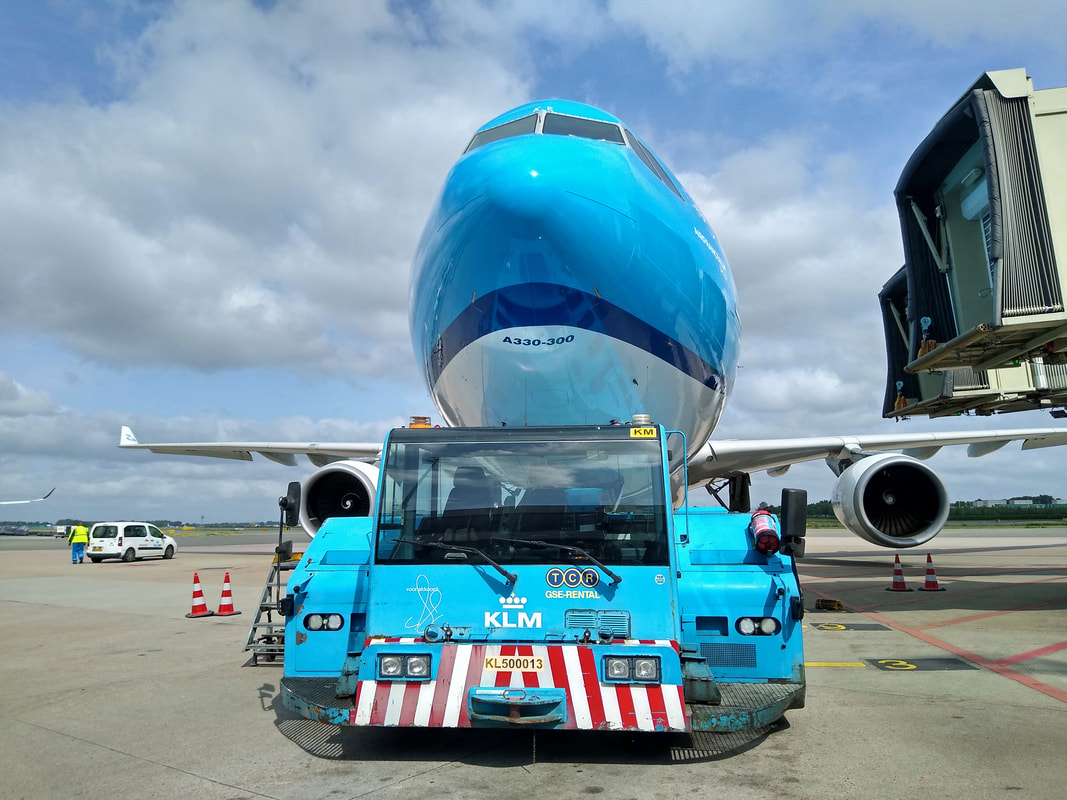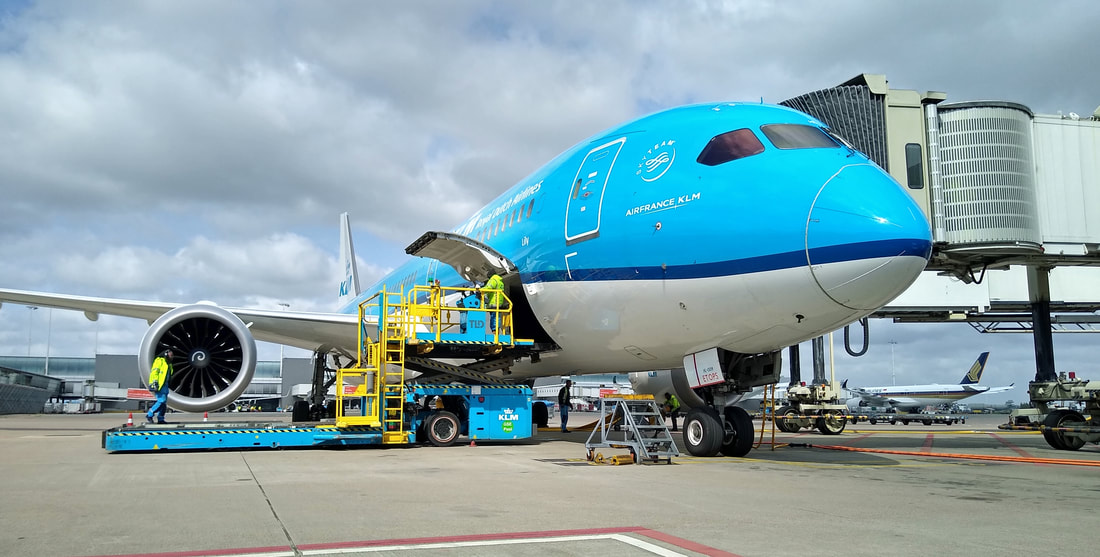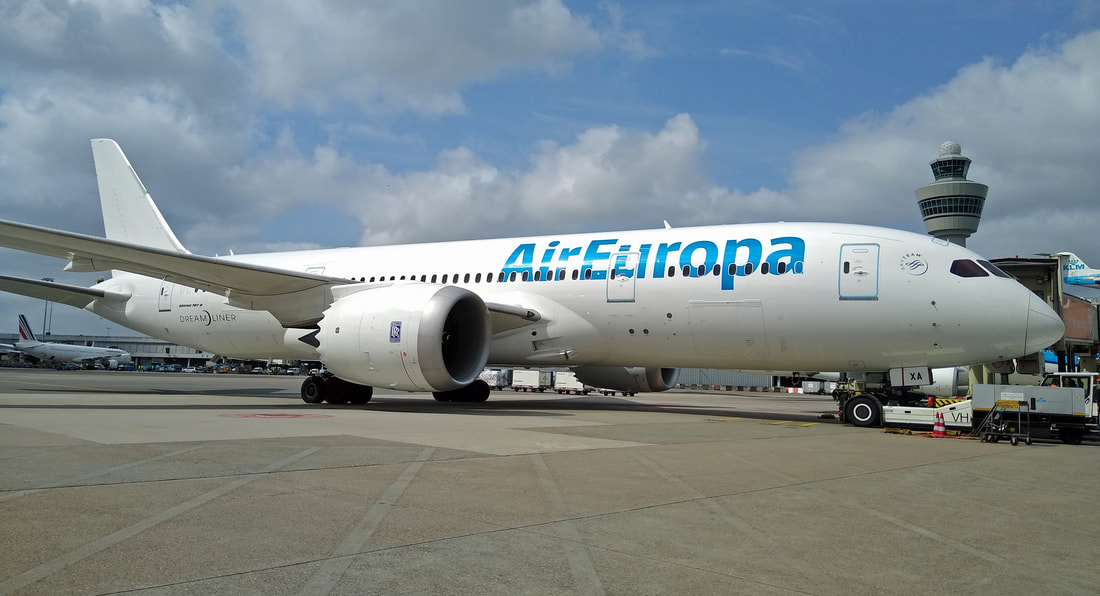Schiphol Jets 2.0
|
|
Welcome on the page Schiphol Jets 2.0. Most pictures were taken during 2019/2020, while I was working for the aircraft towing - and jet- bridge/crew transport department. Enjoy the pics and captions.
A jet bridge (also termed jetway, jetwalk, airgate, gangway, aerobridge/airbridge, skybridge, airtube, expedited suspended passenger entry system (E-SPES), or its official industry name passenger boarding bridge (PBB)) is an enclosed, movable connector which most commonly extends from an airport terminal gate to an airplane, and in some instances from a port to a boat or ship, allowing passengers to board and disembark without going outside and being exposed to harsh weather. Depending on building design, sill heights, fueling positions, and operational requirements, a jet bridge may be fixed or movable, swinging radially, and/or extending in length. The jetway was invented by Frank Der Yuen.
Similar devices are used for astronauts to enter spacecraft, which are installed in the appropriate height of the launch tower.
Before the introduction of jet bridges, passengers normally boarded an aircraft by walking along the ground-level ramp and climbing a set of movable stairs, or airstairs on aircraft so equipped. Mobile staircases or "ramp stairs" are employed at many airports around the world, particularly smaller airports and terminals supporting low cost carriers.
United Airlines tested an early prototype "Air Dock" in 1954. The first operational "Aero-Gangplank", as it was dubbed by inventor Lockheed Air Terminal, was installed by United at Chicago's O'Hare Airport in 1958.
Similar devices are used for astronauts to enter spacecraft, which are installed in the appropriate height of the launch tower.
Before the introduction of jet bridges, passengers normally boarded an aircraft by walking along the ground-level ramp and climbing a set of movable stairs, or airstairs on aircraft so equipped. Mobile staircases or "ramp stairs" are employed at many airports around the world, particularly smaller airports and terminals supporting low cost carriers.
United Airlines tested an early prototype "Air Dock" in 1954. The first operational "Aero-Gangplank", as it was dubbed by inventor Lockheed Air Terminal, was installed by United at Chicago's O'Hare Airport in 1958.
Advantages
Jet bridges provide all-weather dry access to aircraft and enhance the security of terminal operations. They are often permanently attached at one end by a pivot (or rotunda) to the terminal building and have the ability to swing left or right. The cabin, at the end of the loading bridge, may be raised or lowered, extended or retracted, and may pivot, to accommodate aircraft of different sizes. These motions are controlled by an operator's station in the cab. The cab is provided with an accordion-like canopy, which allows the bridge to dock with aircraft with differing shapes, and provide a nearly weather-proof seal. Additionally, many models offer leveling devices for the portion of the floor that makes contact with the aircraft; this allows passengers to slowly transition from level aircraft floor to sloping jet bridge floor. As such, jet bridges provide enhanced access to aircraft for passengers with many types of disabilities and mobility impairments, as they may board and disembark without climbing stairs or using a specialized wheelchair lift.
Some airports with international gates have two or even three bridges for larger aircraft with multiple entrances. In theory, this allows for faster disembarking of larger aircraft, though it is quite common, especially on aircraft such as Boeing 747s and Boeing 777s, to use one bridge for only passengers in first class and/or business class, while the other bridge is for the use of passengers in economy class. In some designs, the second jet bridge would even extend over the aircraft wing, being suspended from an overhead structure. This was, for example, originally adopted for most wide body gates at Amsterdam Airport Schiphol. The Airbus A380 is unique in that both of its two passenger decks have outside access doors and so using loading bridges for each deck is possible, having the advantage of faster aircraft loading (in parallel). Faster loading can lead to lower airport charges, fewer delays and more passenger throughout for the airport, all factors which impact an airline's bottom line.
Though loading bridges are usually permanently attached at their terminal-building end, leaving only the cab free to move, this is not always the case. Those at Melbourne Airport's international terminal are — and at Hong Kong's old Kai Tak Airport were — anchored in the middle and movable at either end to permit the terminal building-end to be raised or lowered to connect with either the departures level or the arrivals level of the terminal building.
Jet bridges provide all-weather dry access to aircraft and enhance the security of terminal operations. They are often permanently attached at one end by a pivot (or rotunda) to the terminal building and have the ability to swing left or right. The cabin, at the end of the loading bridge, may be raised or lowered, extended or retracted, and may pivot, to accommodate aircraft of different sizes. These motions are controlled by an operator's station in the cab. The cab is provided with an accordion-like canopy, which allows the bridge to dock with aircraft with differing shapes, and provide a nearly weather-proof seal. Additionally, many models offer leveling devices for the portion of the floor that makes contact with the aircraft; this allows passengers to slowly transition from level aircraft floor to sloping jet bridge floor. As such, jet bridges provide enhanced access to aircraft for passengers with many types of disabilities and mobility impairments, as they may board and disembark without climbing stairs or using a specialized wheelchair lift.
Some airports with international gates have two or even three bridges for larger aircraft with multiple entrances. In theory, this allows for faster disembarking of larger aircraft, though it is quite common, especially on aircraft such as Boeing 747s and Boeing 777s, to use one bridge for only passengers in first class and/or business class, while the other bridge is for the use of passengers in economy class. In some designs, the second jet bridge would even extend over the aircraft wing, being suspended from an overhead structure. This was, for example, originally adopted for most wide body gates at Amsterdam Airport Schiphol. The Airbus A380 is unique in that both of its two passenger decks have outside access doors and so using loading bridges for each deck is possible, having the advantage of faster aircraft loading (in parallel). Faster loading can lead to lower airport charges, fewer delays and more passenger throughout for the airport, all factors which impact an airline's bottom line.
Though loading bridges are usually permanently attached at their terminal-building end, leaving only the cab free to move, this is not always the case. Those at Melbourne Airport's international terminal are — and at Hong Kong's old Kai Tak Airport were — anchored in the middle and movable at either end to permit the terminal building-end to be raised or lowered to connect with either the departures level or the arrivals level of the terminal building.
Disadvantages
Loading bridges restrict aircraft parking to spots immediately adjacent to the terminal. Thus, airports use mobile staircases to facilitate disembarking at hardstands (remote parking positions).
Loading bridges may pose hazards to aircraft if handled improperly. If the bridge is not retracted fully before departure, it may contact protruding parts of the taxiing aircraft (e.g., a pitot tube), requiring repair and delays. Furthermore, during cold weather, the loading bridge may become frozen to the aircraft. In this case, when the jet bridge retracts, it could damage the aircraft if that area has not been properly de-iced.
When regional jets are used, jet bridges have another disadvantage, since they allow only one aircraft to park at the gate at a time. Several airlines have removed jet bridges at regional jet gates at airports such as Atlanta which are short on gates. When having passengers disembark on the ramp or apron, airlines can fit two or more regional jets per gate. In many other places like Beijing Capital Airport and Paris Charles de Gaulle Airport, a gate for large aircraft can be used to accommodate two smaller aircraft like Boeing 737s or Airbus A320s.
Several incidents of jet bridges collapsing include Sydney, Hong Kong, Seattle, Los Angeles, Baltimore, and Islamabad.
Airports frequently charge increased fees for using loading bridges on stands as opposed to mobile stairs, therefore low-cost airlines such as Ryanair have avoided using these wherever possible.
Jet bridges are occasionally used at smaller, single-story airports. This is accomplished by a flight of stairs and, in some instances, a wheelchair lift. In this scenario, a passenger proceeds through the gate and then up a flight of stairs to meet the height of the jet bridge. An example of this can be found at South Bend International Airport. Alternatively, a ramp can be used in the terminal building to bring the passengers from the waiting area to the height of the jet bridge. For example, Sawyer International Airport has jet bridges that can load passengers onto smaller passenger aircraft such as the Saab 340 turboprop. The Ithaca Tompkins Regional Airport has two gates using this approach. This can be done to attract larger airlines that require use of a jet bridge to the airport, as well as to make disembarking smaller planes easier for disabled people and to improve the disembarking process in bad weather.
Loading bridges restrict aircraft parking to spots immediately adjacent to the terminal. Thus, airports use mobile staircases to facilitate disembarking at hardstands (remote parking positions).
Loading bridges may pose hazards to aircraft if handled improperly. If the bridge is not retracted fully before departure, it may contact protruding parts of the taxiing aircraft (e.g., a pitot tube), requiring repair and delays. Furthermore, during cold weather, the loading bridge may become frozen to the aircraft. In this case, when the jet bridge retracts, it could damage the aircraft if that area has not been properly de-iced.
When regional jets are used, jet bridges have another disadvantage, since they allow only one aircraft to park at the gate at a time. Several airlines have removed jet bridges at regional jet gates at airports such as Atlanta which are short on gates. When having passengers disembark on the ramp or apron, airlines can fit two or more regional jets per gate. In many other places like Beijing Capital Airport and Paris Charles de Gaulle Airport, a gate for large aircraft can be used to accommodate two smaller aircraft like Boeing 737s or Airbus A320s.
Several incidents of jet bridges collapsing include Sydney, Hong Kong, Seattle, Los Angeles, Baltimore, and Islamabad.
Airports frequently charge increased fees for using loading bridges on stands as opposed to mobile stairs, therefore low-cost airlines such as Ryanair have avoided using these wherever possible.
Jet bridges are occasionally used at smaller, single-story airports. This is accomplished by a flight of stairs and, in some instances, a wheelchair lift. In this scenario, a passenger proceeds through the gate and then up a flight of stairs to meet the height of the jet bridge. An example of this can be found at South Bend International Airport. Alternatively, a ramp can be used in the terminal building to bring the passengers from the waiting area to the height of the jet bridge. For example, Sawyer International Airport has jet bridges that can load passengers onto smaller passenger aircraft such as the Saab 340 turboprop. The Ithaca Tompkins Regional Airport has two gates using this approach. This can be done to attract larger airlines that require use of a jet bridge to the airport, as well as to make disembarking smaller planes easier for disabled people and to improve the disembarking process in bad weather.
Use and appearance
At the airport terminal, the bridge is connected to a portal (called a "gate") in the terminal wall behind the gate desk. Once airplane boarding starts, passengers hand their boarding passes to the gate's attendant, who lets them pass through.
Inside, the bridge looks like a narrow, lighted hallway, without doors. Loading bridges usually have no windows, but glass walls are becoming more common. The walls are normally painted in accordance with airline standards, generally with relaxing colors. Some bridges have advertisements on interior or exterior walls. The floor is generally uneven with many bumps, creating a hazard for wheelchairs and individuals with mobility issues.
By using a retractable tunnel design, loading bridges may retract and extend varying lengths. Some airports use fixed walkways to effectively extend the reach of a loading bridge. The fixed walkway extends out from the terminal building and connects to the loading bridge rotunda. Occasionally, fixed bridges lead to multiple loading bridges. There are some jetways (such as several older bridges on the north terminal at Edmonton International Airport) that sit directly on the ground, as opposed to supports. These jetways are often used by small airlines or airplanes that are sometimes too low for conventional jetways (such as the Dash 8 and CRJ).
The cab of the loading bridge is raised and lowered to dock with aircraft of differing sill heights. The height of the cab is matched to the height of the aircraft door sill height. This often results in a slope along the length of the loading bridge.
Controls in older systems contain a large number of individual motor control buttons, with efficient operation requiring a high degree of operator skill and experience. Modern control consoles are much simpler, with only a few buttons, a graphic display console, and a single multi-axis joystick, with an overall appearance similar to that of a video game console in a video arcade.
At the airport terminal, the bridge is connected to a portal (called a "gate") in the terminal wall behind the gate desk. Once airplane boarding starts, passengers hand their boarding passes to the gate's attendant, who lets them pass through.
Inside, the bridge looks like a narrow, lighted hallway, without doors. Loading bridges usually have no windows, but glass walls are becoming more common. The walls are normally painted in accordance with airline standards, generally with relaxing colors. Some bridges have advertisements on interior or exterior walls. The floor is generally uneven with many bumps, creating a hazard for wheelchairs and individuals with mobility issues.
By using a retractable tunnel design, loading bridges may retract and extend varying lengths. Some airports use fixed walkways to effectively extend the reach of a loading bridge. The fixed walkway extends out from the terminal building and connects to the loading bridge rotunda. Occasionally, fixed bridges lead to multiple loading bridges. There are some jetways (such as several older bridges on the north terminal at Edmonton International Airport) that sit directly on the ground, as opposed to supports. These jetways are often used by small airlines or airplanes that are sometimes too low for conventional jetways (such as the Dash 8 and CRJ).
The cab of the loading bridge is raised and lowered to dock with aircraft of differing sill heights. The height of the cab is matched to the height of the aircraft door sill height. This often results in a slope along the length of the loading bridge.
Controls in older systems contain a large number of individual motor control buttons, with efficient operation requiring a high degree of operator skill and experience. Modern control consoles are much simpler, with only a few buttons, a graphic display console, and a single multi-axis joystick, with an overall appearance similar to that of a video game console in a video arcade.
Marketing
Marketing space on jetways was uncommon until the early 2000s when HSBC launched their campaign "The World's Local Bank.
Peter Stringham, head of marketing for HSBC worldwide, worked closely with Lowe's, the Group's global agency, in developing the campaign which required a single global platform. Stringham noticed jetways were a global medium which had not been tapped. HSBC thus bought the rights to jetways across major localities in 81 countries and territories.
Marketing space on jetways was uncommon until the early 2000s when HSBC launched their campaign "The World's Local Bank.
Peter Stringham, head of marketing for HSBC worldwide, worked closely with Lowe's, the Group's global agency, in developing the campaign which required a single global platform. Stringham noticed jetways were a global medium which had not been tapped. HSBC thus bought the rights to jetways across major localities in 81 countries and territories.
It’s Winter Time: Aeroflot A320 at the G-Gate at SPL.
Turkish Airlines A330-300, TC-JNS, named “Hattuşaş” rests at the G Terminal, AMS, January 2020.
AnadoluJet has just arrived from Istanbul Sabiha Gökçen International Airport.
TC-JKV at AMS in January 2020. External electrical power is plugged in and the water service truck under the tail is doing what it does.
Delta Airlines A350-900, N515DN , taxiing out at Amsterdam-Schiphol, bound for Minneapolis, in January 2020.
The 350 has beautiful designed curved winglets.
Winter at Schiphol.
Zorro masked Air Canada bird.
PH-BVB taxies into her base at Amsterdam-Schiphol.
A350-900, B-18912, of China Airlines, starting engines for departure from Amsterdam on February 27, 2022.
During the COVID-19 period, cargo capacity, on long-haul trade lanes, remaining tight.
KLM Cityhopper, operates a large fleet of Embraer 175 and 190's from its Amsterdam headquarters.
PH-EXI serving with KLM Cityhopper.
PH-BGX and a friend at Amsterdam.
Watch-out for those pitot tubes & angle of attack vane!
Belavia, EW-366PA, ready to heading home to Minsk.
Watch-out for those pitot tubes & angle of attack vane!
Gritty performer in gritty weather is this classic 737-300, EW-254PA, in WORLD of TANKS colors. She was (December 24, 2020) picking-up passengers, for their flight to Minsk, Belarus, at Schiphol's gate E04.
A ground power unit pumps energy into a stationary Boeing 737-300 as it being handled on the gateE4 at Amsterdam.
The Boeing 777-300 forms the backbone of KLM’s long-haul services.
It’s Winter Time: An American Airlines Dreamliner at her parking spot at AMS during February 2021.
The Embraer Twinjet gained a large stronghold in Europe as a popular short-to-medium range aircraft with major flag carriers such as KLM, Air France and Alitalia.
Twinjets.
This is one of 50+ Embraers operated by Amsterdam-Schiphol based KLM Cityhopper.
PH-EZC and PH-EXT are both working for KLM Cityhopper.
Oldjets.net management-team on duty, on a bright day in 2019.
Embraer 190, PH-EZO, is one of a number operated by KLM Cityhopper on the company's network.
"The DELTA Spirit - Keep Climbing Together"
Ship '3502' is a brand new Airbus 350-900 N502DN.
Embraer 190, PH-EXB, operates local services from Schiphol for KLM Cityhopper.
Two Amsterdam-based Embraers are clocking up hours on KLM Cityhopper Inter-European scheduled services.
KLM Cityhopper, Amsterdam based, Embraers are hard working airplanes.
A KLM Cityhopper Embraer-175 upon pushback.
The Embraer has cemented its own niche in the Inter-European schedules services with many European airlines.
Twinjet ready for action.
She worked for KLM Cityhopper on the Inter-European routes until superseded by more effient E2's in 2022.
This Air Baltic A220 has the looks of former Calder/Braniff Flying colors DC-8-62 N1805.
KLM Royal Dutch Airlines Boeing 777-300 at AMS in 2022. External electrical power is plugged in, the catering truck is busy at the forward galley, bags on the belt loader behind the right wing are being handled and the lav service truck behind the left wing is doing what it does.
A rather overcast day at Amsterdam/Schiphol.
Forward cargo-door open, a pristine Cathay Pacific Airbus 350 has an aura of understated efficiency.
A KLM Dreamliner in the summer-time sunshine glow.
A KLM Dreamliner almost ready for pushing back at Amsterdam Schiphol in August 2022.
It has been clouded all morning.
Delta, #3319, pulling up to the gate at Amsterdam.
Amsterdam 15.01.2021. G-ZBJH being unloaded on a cold damp day.
Sadly, a murky day for this interesting visitor.
From my warm office, I stepped out on to the ramp, where I was confronted with that damp, cold Dutch wind and spitting drizzle.
The weather at Amsterdam/Schiphol was gray, wet and dark.
A wet Sunday morning in Holland. Captioned '254PA", dates from around 1993 or early 1994.
Close cropped front starboard side view of Belavia Boeing 737-300 EW-254PA.
The aircraft is pictured under a rain-washed northwestern sky in the winter of 2021.
PH-EZU serving with KLM Cityhopper, at Amsterdam.
PH-EXF getting fuel at Gate 32.
She was seen at a winterized Amsterdam, Netherlands, where fuel was uplifted.
PH-EXF getting fuel at Amsterdam.
KLM Cityhopper Embraer 190, PH-EXF, prepping for another scheduled flight to the Aberdeen, Scotland.
Another Cityhopper on block after its flight from Florance, Italy.
General Electric 34-8E powered Embraer 175, PH-EXI just arrived and is awaiting stairs and a ground power unit.
It was very cold, that day!
KLM Cityhopper operates a large fleet of Embraers from its Amsterdam base on scheduled Inter-European services to, among others, London-City, Aberdeen, Oporto, Bordeaux and Stavanger.
The E175 and E190 will be superseded by the far more efficient Embraer E2.
Lined-up KLM Cityhopper Embraers at Amsterdam-Schiphol on a very cold day in January 2022.
It was a cold but beautiful day at Schiphol.
PH-BQE wintering at Buffer D98.
Fortunately, the sun is still shining over a Covid-19 invested world.
PH-EZT getting fuel on a cold but cristal clear blue day in February 2021.
Last revenue flight for PH-BFY was MEX/AMS.
After a couple years of storage, VT-JEW, was ferried to Victorville.
Jet Airways VT-JEW became N377CL and acquired by IAG Aero Group for part-out and scrap at Mojave.
PH-BXM captured by the camera on finals to runways 06 at Amsterdam-Schiphol.
Ryanair 737 inbound on short final from Dublin.
Covid-19 victums.
PH-HXF, wearing GOL Brasil colors is seen here at Schiphol-East partly cocooned due the economic Covid-19 down-turn.
Hatches, engine and air conditioning intakes and other orifices are hermetically sealed to prevent dust and moisture penetrating the aircraft’s systems and interior, thus preserving the aircraft in as good a condition as possible.
PH-HXJ, unfortunately out of service and cocooned at Schiphol-East during the Covid-19 period.
Due to Covid a lot of hardware was grounded and cocooned.
Schiphol-East, playground for the rich and shameless.
There was sufficient business for these bizz-jets during the Covid-19 period.
During Covid, PH-BQD, was withdrawn from service and stored at Amsterdam.
Nasty times ahead!
Three 747's who lost their Crown!
This is what we never want to see anymore!
F-STAJ is being prepared for flight AF1441 to Paris-Charles de Gaulle.
PH-BXY just arrived at Schiphol's gate C-9, as flight KL1118, from Stockholm, Sweden.
This British Airways A320 is almost ready to heading home to London.
Departure back to Warsaw as LO268.
An Etihad Dreamliner upon push-back.
Etihad, flight EY78, is push away from gate E-18.
Peter Pan was spending the night at Schiphol.
Flight JU365 is being fueled for her flight back to Belgrade.
The very low morning light is yet not able to catch this Cathay Pacific Airbus 350, half-asleep, at Schiphol's E-18 gate.
Amsterdam-Schiphol. Time: 07:15LT.
I always like a nice crisp morning to start my work a Amsterdam-Schiphol.
Air Europa 'Zulu Gulf' awaiting her passenger at Amsterdam-Schiphol D-terminal.
Soft winter light on this Air Europa Dreamliner at Schiphol D47 gate.
'Zulu Gulf' was operating flight UX1098 to Madrid.
Very low morning light cathes this 737 on the ramp at Amsterdam.
The aviobridge forms a fitting frame for this KLM Boeing 737.
HOP Embraer 190, F-HBLA, was going to Marseille as AF1807.
PH-EXK was built in 2017.
Rows of KLM Cityhopper Embraers can be found at Schiphol's A-platform.
PH-EXV warming herself up in the early mornig sun. Schiphol, January 2023.
PH-EXV has serial number 750.
PH-EXK is seen here defrosting herself at Schiphol's A-ramp. January 15, 2023.
A ground power unit pumps energy into PH-BQK, which just arrived from Taipei, Taiwan.
Boeing 777-200 of KLM is seen here approached by aircraft handlers at Amsterdam on January 15, 2023.
Service vehicles move out to meet PH-BQK.
Boeing 777-200, PH-BQK, off-loading ULD's.
KLM's PH-BQK loads late in the afternoon.
KM394 arriving from Malta on this overcasted day.
9H-NEO rolls into Amsterdam on a wet morning.
Air Malta A320NEO taxies into her gate at Amsterdam.
Airbus A320NEO, 9H-NEO, just arrived and is awaiting blocks, groundpower and aviobridge connecting.
Chocks in place.
9H-NEO on a rainy Amsterdam ramp.
Airbus A320NEO, 9H-NEO, being fueled prior her flight back to Malta.
Cathay Pacific A350, B-LXH, is seen here unloading at Amsterdam in great morning light.
Early morning engine-wash at Schiphol-Amsterdam.
A6-EPO serving with Emirates.
Rampscene at Amsterdam-Schiphol. Spring 2023.
The Boeing 777 forms the backbone of KLM’s long-haul services.
KLM Boeing 777, PH-BVO, wears fleetnumbeer VO-034.
The Boeing Dreamliner is a favorite aircraft for many worldwide airliners and charter operators.
Workhorse of KLM is 'Mount Kilimanjaro'.
KLM’s stalwart fleet of 777's are the backbone of its services from its Amsterdam-Schiphol base.
China Airlines operates a fleet of Airbus 350's from its Taipei base on scheduled services to Amsterdam.
Pictured at the gate is this Delta Airlines Airbus 350, Schiphol spring 2023.
This Dreamliner is one of a number operated by KLM on the company's network.
This 'Super FLUF' is seen prepared for her up-coming flight to Lisbon.
This 'Longdart' is working for SAS since December 2017.
This Delta 'Seventh Wonder' is awaiting her next flight at one of Schiphol's gate.
This former Northwest Airlines 'Big Bus' is seen catered at one of the D-gates.
One of KLM's 'Plastic Princesses' is seen at gate E24.
PH-AOB was delivered to the KLM in December 2006.
'Big Bus' PH-AOF is seen here being cleaned and watered at the E-buffer.
An EasyJet 'Minibus' is seen resting at the E-buffer.
Before Air Europa, EC-NXA, flew for Norwegian Long Haul.
- The End -



